




Millions of Americans receiving food assistance benefits just earned a new right that they can’t yet enforce: The right to be reimbursed if funds on their Electronic Benefit Transfer (EBT) cards are stolen by card skimming devices secretly installed at cash machines and grocery store checkout lanes.

On December 29, 2022, President Biden signed into law the Consolidated Appropriations Act of 2023, which — for the first time ever — includes provisions for the replacement of stolen EBT benefits. This is a big deal because in 2022, organized crime groups began massively targeting EBT accounts — often emptying affected accounts at ATMs immediately after the states disperse funds each month.
EBT cards can be used along with a personal identification number (PIN) to pay for goods at participating stores, and to withdraw cash from an ATM. However, EBT cards differ from debit cards issued to most Americans in two important ways. First, most states do not equip EBT cards with smart chip technology, which can make the cards more difficult and expensive for skimming thieves to clone.
More critically, EBT participants traditionally have had little hope of recovering food assistance funds when their cards were copied by card-skimming devices and used for fraud. That’s because while the EBT programs are operated by individually by the states, those programs are funded by the U.S. Department of Agriculture (USDA), which until late last year was barred from reimbursing states for stolen EBT funds.
The protections passed in the 2023 Appropriations Act allow states to use federal funds to replace stolen EBT benefits, and they permit states to seek reimbursement for any skimmed EBT funds they may have replaced from their own coffers (dating back to Oct. 1, 2022).
But first, all 50 states must each submit a plan for how they are going to protect and replace food benefits stolen via card skimming. Guidance for the states in drafting those plans was issued by the USDA on Jan. 31 (PDF), and states that don’t get them done before Feb. 27, 2023 risk losing the ability to be reimbursed for EBT fraud losses.
Deborah Harris is a staff attorney at The Massachusetts Law Reform Institute (MLRI), a nonprofit legal assistance organization that has closely tracked the EBT skimming epidemic. In November 2022, the MLRI filed a class-action lawsuit against Massachusetts on behalf of thousands of low-income families who were collectively robbed of more than $1 million in food assistance benefits by card skimming devices secretly installed at cash machines and grocery store checkout lanes across the state.
Harris said she’s pleased that the USDA guidelines were issued so promptly, and that the guidance for states was not overly prescriptive. For example, some security experts have suggested that adding contactless capability to EBT cards could help participants avoid skimming devices altogether. But Harris said contactless cards do not require a PIN, which is the only thing that stops EBT cards from being drained at the ATM when a participant’s card is lost or stolen.
Then again, nothing in the guidance even mentions chip-based cards, or any other advice for improving the physical security of EBT cards. Rather, it suggests states should seek to develop the capability to perform basic fraud detection and alerting on suspicious transactions, such as when an EBT card that is normally used only in one geographic area suddenly is used to withdraw cash at an ATM halfway across the country.
“Besides having the states move fast to approve their plans, we’d also like to see a focused effort to move states from magstripe-only cards to chip, and also assisting states to develop the algorithms that will enable them to identify likely incidents of stolen benefits,” Harris said.
Harris said Massachusetts has begun using algorithms to look for these suspicious transaction patterns throughout its EBT network, and now has the ability to alert households and verify transactions. But she said most states do not have this capability.
“We have heard that other states aren’t currently able to do that,” Harris said. “But encouraging states to more affirmatively identify instances of likely theft and assisting with the claims and verification process is critical. Most households can’t do that on their own, and in Massachusetts it’s very hard for a person to get a copy of their transaction history. Some states can do that through third-party apps, but something so basic should not be on the burden of EBT households.”
Some states aren’t waiting for direction from the federal government to beef up EBT card security. Like Maryland, which identified more than 1,400 households hit by EBT skimming attacks last year — a tenfold increase over 2021.
Advocates for EBT beneficiaries in Maryland are backing Senate Bill 401 (PDF), which would require the use of chip technology and ongoing monitoring for suspicious activity (a hearing on SB401 is scheduled in the Maryland Senate Finance Commission for Thursday, Feb. 23, at 1 p.m.).
Michelle Salomon Madaio is a director at the Homeless Persons Representation Project, a legal assistance organization based in Silver Spring, Md. Madaio said the bill would require the state Department of Human Services to replace skimmed benefits, not only after the bill goes into effect but also retroactively from January 2020 to the present.
Madaio said the bill also would require the state to monitor for patterns of suspicious activity on EBT cards, and to develop a mechanism to contact potentially affected households.
“For most of the skimming victims we’ve worked with, the fraudulent transactions would be pretty easy to spot because they mostly happened in the middle of the night or out of state, or both,” Madaio said. “To make matters worse, a lot of families whose benefits were scammed then incurred late fees on many other things as a result.”
It is not difficult to see why organized crime groups have pounced on EBT cards as easy money. In most traditional payment card transactions, there are usually several parties that have a financial interest in minimizing fraud and fraud losses, including the bank that issued the card, the card network (Visa, MasterCard, Discover, etc.), and the merchant.
But that infrastructure simply does not exist within state EBT programs, and it certainly isn’t a thing at the inter-state level. What that means is that the vast majority of EBT cards have zero fraud controls, which is exactly what continues to make them so appealing to thieves.
For now, the only fraud controls available to most EBT cardholders include being especially paranoid about where they use their cards, and frequently changing their PINs.
According to USDA guidance issued prior to the passage of the appropriations act, EBT cardholders should consider changing their card PIN at least once a month.
“By changing PINs frequently, at least monthly, and doing so before benefit issuance dates, households can minimize their risk of stolen benefits from a previously skimmed EBT card,” the USDA advised.
Microsoft is sending the world a whole bunch of love today, in the form of patches to plug dozens of security holes in its Windows operating systems and other software. This year’s special Valentine’s Day Patch Tuesday includes fixes for a whopping three different “zero-day” vulnerabilities that are already being used in active attacks.

Microsoft’s security advisories are somewhat sparse with details about the zero-day bugs. Redmond flags CVE-2023-23376 as an “Important” elevation of privilege vulnerability in the Windows Common Log File System Driver, which is present in Windows 10 and 11 systems, as well as many server versions of Windows.
“Sadly, there’s just a little solid information about this privilege escalation,” said Dustin Childs, head of threat awareness at Trend Micro’s Zero Day Initiative. “Microsoft does note that the vulnerability would allow an attacker to exploit code as SYSTEM, which would allow them to completely take over a target. This is likely being chained with a remote code execution bug to spread malware or ransomware. Considering this was discovered by Microsoft’s Threat Intelligence Center, it could mean it was used by advanced threat actors. Either way, make sure you test and roll these fixes quickly.”
The zero-day CVE-2023-21715 is a weakness in Microsoft Office that Redmond describes as a “security feature bypass vulnerability.”
“Microsoft lists this as under active exploit, but they offer no info on how widespread these exploits may be,” Childs said. “Based on the write-up, it sounds more like a privilege escalation than a security feature bypass, but regardless, active attacks in a common enterprise application shouldn’t be ignored. It’s always alarming when a security feature is not just bypassed but exploited. Let’s hope the fix comprehensively addresses the problem.”
The third zero-day flaw already seeing exploitation is CVE-2023-21823, which is another elevation of privilege weakness — this one in the Microsoft Windows Graphic component. Researchers at cybersecurity forensics firm Mandiant were credited with reporting the bug.
Kevin Breen, director of cyber threat research at Immersive Labs, pointed out that the security bulletin for CVE-2023-21823 specifically calls out OneNote as being a vulnerable component for the vulnerability.
“In recent weeks, we have seen an increase in the use of OneNote files as part of targeted malware campaigns,” Breen said. “Patches for this are delivered via the app stores and not through the typical formats, so it’s important to double check your organization’s policies.”
Microsoft fixed another Office vulnerability in CVE-2023-21716, which is a Microsoft Word bug that can lead to remote code execution — even if a booby-trapped Word document is merely viewed in the preview pane of Microsoft Outlook. This security hole has a CVSS (severity) score of 9.8 out of a possible 10.
Microsoft also has more valentines for organizations that rely on Microsoft Exchange Server to handle email. Redmond patched three Exchange Server flaws (CVE-2023-21706, CVE-2023-21707, and CVE-2023-21529), all of which Microsoft says are remote code execution flaws that are likely to be exploited.
Microsoft said authentication is required to exploit these bugs, but then again threat groups that attack Exchange vulnerabilities also tend to phish targets for their Exchange credentials.
Microsoft isn’t alone in dropping fixes for scary, ill-described zero-day flaws. Apple on Feb. 13 released an update for iOS that resolves a zero-day vulnerability in Webkit, Apple’s open source browser engine. Johannes Ullrich at the SANS Internet Storm Center notes that in addition to the WebKit problem, Apple fixed a privilege escalation issue. Both flaws are fixed in iOS 16.3.1.
“This privilege escalation issue could be used to escape the browser sandbox and gain full system access after executing code via the WebKit vulnerability,” Ullrich warned.
On a lighter note (hopefully), Microsoft drove the final nail in the coffin for Internet Explorer 11 (IE11). According to Redmond, the out-of-support IE11 desktop application was permanently disabled on certain versions of Windows 10 on February 14, 2023 through a Microsoft Edge update.
“All remaining consumer and commercial devices that were not already redirected from IE11 to Microsoft Edge were redirected with the Microsoft Edge update. Users will be unable to reverse the change,” Microsoft explained. “Additionally, redirection from IE11 to Microsoft Edge will be included as part of all future Microsoft Edge updates. IE11 visual references, such as the IE11 icons on the Start Menu and taskbar, will be removed by the June 2023 Windows security update (“B” release) scheduled for June 13, 2023.”
For a more granular rundown on the updates released today, see the SANS Internet Storm Center roundup. If today’s updates cause any stability or usability issues in Windows, AskWoody.com will likely have the lowdown on that.
Please consider backing up your data and/or imaging your system before applying any updates. And feel free to sound off in the comments if you experience any problems as a result of these patches.



Providing secure access and a frictionless user experience are typically competing initiatives, but they don’t have to be! Read on to learn why.
In our world today, context changes quickly. We work from home, coffee shops and the office. We use multiple devices to do work. And on the flip side, attackers are becoming increasingly savvy, getting around security controls, such as multi-factor authentication (MFA), to gain unauthorized access.
To quote Wendy Nather, Cisco’s head of Advisory CISOs, “Trust is neither binary nor permanent.” Therefore, security controls must constantly evaluate for change in trust, but without adding unnecessary friction for end-users.
It’s no surprise that the recently published Cybersecurity Readiness Index, a survey of 6,700 cybersecurity leaders from across the globe, revealed that more progress is needed to protect identity, networks and applications.
To address these challenges and to make zero trust access for the workforce easy and frictionless, Cisco Duo announced the general availability of Risk-Based Authentication and enhancements to our enterprise ready Single Sign-On solution at Cisco Live EMEA 2023 earlier this week.
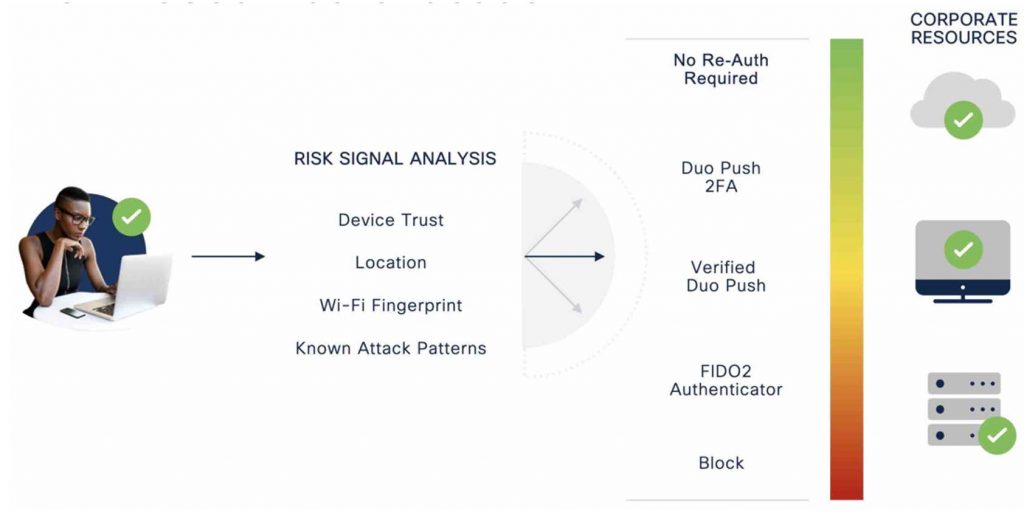
Risk-Based Authentication fulfills the zero trust philosophy of continuous trust verification by assessing the risk level for each access attempt in a manner that is frictionless to users. A higher level of authentication is required only when there is an increase in assessed risk. Duo dynamically detects risk and automatically steps up authentication with two key policies:
The Risk-Based Factor Selection policy detects and analyzes authentication requests and adaptively enforces the most secure factors. It highlights risk and adapts its understanding of normal user behavior. It does this by looking for known attack patterns and anomalies and then allowing only the more secure authentication methods to gain access.
For example, Duo can detect if an organization or employee is being targeted for a push bombing attack or if the authentication device and access device are in two different countries, and Duo responds by automatically elevating the authentication request to a more secure factor such as phishing resistant FIDO2 security keys or Verified Duo Push.
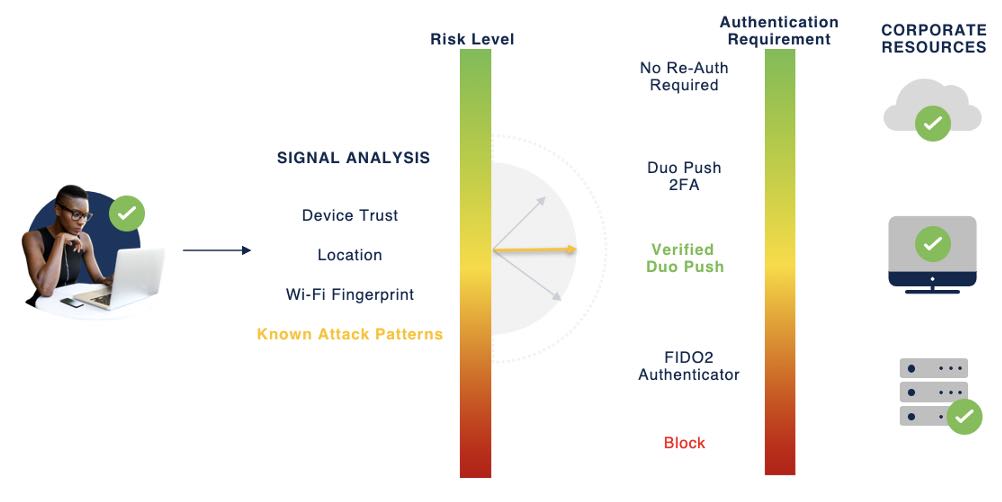
The Risk-Based Remembered Devices policy establishes a trusted device session (like “remember this computer” check box), automatically without asking the user the check a box, during a successful authentication. Once the session is established, Duo looks for anomalous IP addresses or changes to a device throughout the lifetime of the trusted session and requires re-authentication only if it observes a change from historical baselines.
The policy also incorporates a Wi-Fi Fingerprint provided by Duo Device Health app to ensure that IP address changes reflect actual changes in location and not normal usage scenarios such as a user establishing an organizational VPN (Virtual Private Network) session.
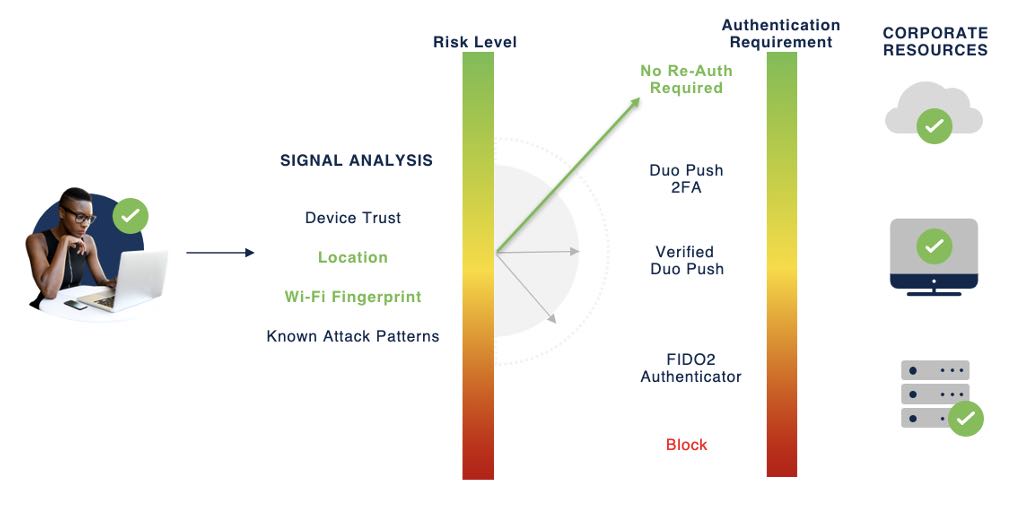
Duo uses anonymized Wi-Fi Fingerprint to reliably detect whether the access device is in the same location as it was for previous authentications by comparing the Wi-Fi networks that are “visible” to the access device. Further, Duo preserves user privacy and does not track user location or collect any private information. Wi-Fi Fingerprint only lets Duo know if a user has changed location.
A typical organization uses over 250 applications. Single sign-on (SSO) solutions help employees access multiple applications with a single set of credentials and allow administrators to enforce granular policies for application access from a single console. Integrated with MFA or passwordless authentication, SSO serves as a critical access management tool for organizations that want to implement zero trust access to corporate applications.
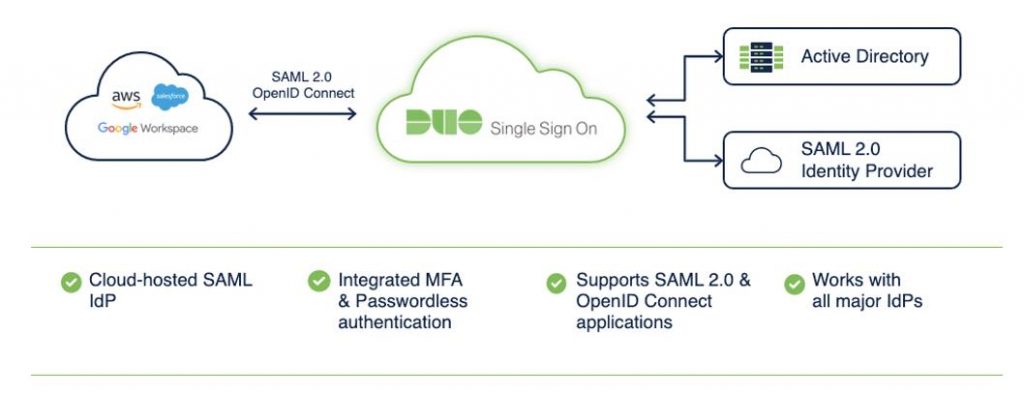
Duo SSO is already popular among Duo’s customers. Now, we are adding two new capabilities that cater to modern enterprises:
An increasing number of applications use OIDC for authentication. It is a modern authentication protocol that lets application and website developers authenticate users without storing and managing other people’s passwords, which is both difficult and risky. To date, Duo SSO has supported SAML web applications. Supporting OIDC allows us to protect more of the applications that our customers are adopting as we all move towards a mobile-first world and integrate stronger and modern authentication methods.
Password resets are expensive for organizations. It is estimated that 20-50% of IT helpdesk tickets are for password resets. And according to a report by Ponemon Institute, large enterprises experience an average loss of $5.2 million a year in user productivity due to password resets.
When logging into browser-based applications, Duo SSO already allows users to reset passwords when they have expired in the same login workflow. And we heard from our customers that users want the option to proactively reset passwords. Now, Duo SSO offers the convenience to reset their Active Directly passwords before they expire. This capability further increases user productivity and reduces IT helpdesk tickets.
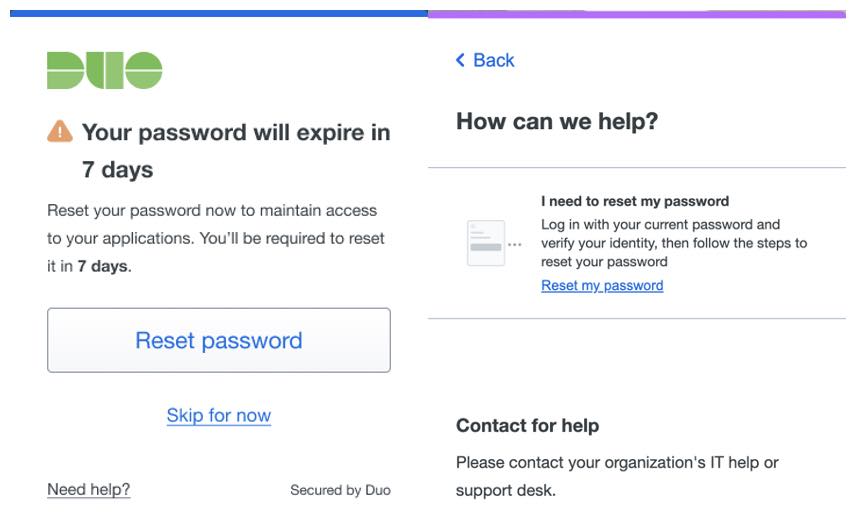
Risk-Based Authentication and enhancements to Duo SSO are available now to all paying customers based on their Duo Edition. If you are not yet a Duo customer, sign up for a free 30-day trial and try out these new capabilities today!
We’d love to hear what you think. Ask a Question, Comment Below, and Stay Connected with Cisco Secure on social!
Cisco Secure Social Channels
Cisco Live is the premier destination for Cisco customers and partners to gain knowledge and build community. Our teams work hard to deliver education and inspiration, ignite creativity, deliver practical know-how, and accelerate the connections that fuel your digital future.
The Cisco Secure team is excited to share our expertise to help power the strategies – and safety – of your organization.
In 2023, the threat landscape will evolve to one that sees attacks on every surface, from criminals who are opportunistic, yet laser-focused on their goal. The attacks themselves could be email-borne, directly targeted, socially based, or a mix of all three.
Criminals will target vulnerabilities, operational deficiencies, suppliers, and business partners, as a means of accomplishing their goals. They will use the target’s own environment and take advantage of existing people and technology problems, including alert fatigue and staffing shortages.
To face this reality and address the needs of organizations both large and small, Cisco will continue to focus on education and innovation in the areas of preventing insider threats, providing consistent and informed alerts, enabling actionable intelligence, and delivering solutions to implement a zero-trust security framework.
As the organization that pioneered networking, we are driven to secure every connection, providing end-to-end protection for users and devices across multiple clouds and networks with a seamless experience.
As our vision for the integrated Cisco Security Cloud evolves, we’re continuing to challenge existing models and unify security and networking, with foundational elements that execute on this vision. From verified push – which protects organizations from MFA-focused phishing attacks – to Wi-Fi Fingerprint, and Remembered Devices, the performance enhancements with Enterprise Single Sign-on and Cisco+ Secure Connect, we continue to meet our customers where they are, offering true zero trust, with frictionless experiences for the hybrid workforce.
We’re excited to celebrate the following innovations and updates announced at Cisco Live EMEA:
Finding the balance between usability and security is now easier than ever. With Risk-Based Authentication, users have the access they need, secured by real-time contextual signals. Organizations can increase security efficacy by dynamically adjusting authentication requirements based on risk levels and by enabling safer end-user behavior. Risk-based authentication now includes wi-fi fingerprint, remembered device, and verified push features, which work together to reduce risk while preserving user experience by only requesting additional interaction for suspicious logins or a change in risk.
Our Enterprise Ready Single Sign-on expands Duo SSO with three new capabilities to easily connect single sign-on to modern apps and empower end users. By adding major protocol support, improved admin tooling, and SSO on demand password resets, organizations enable easier and more secure access from anywhere.
Cisco SD-WAN customers can now enjoy all the benefits of a turnkey, single-vendor SASE solution that brings together industry-leading networking with security: Cisco+ Secure Connect. This new integration gives Cisco SD-WAN (powered by Viptela) customers fast, secure private application and internet access, enabling them to deliver a secure experience, anywhere work happens.
We are also announcing the introduction of industry-first Business Risk Observability, an enhancement of our Full-Stack Observability application security solution. Available through Cisco Secure Application, which is integrated into Cisco AppDynamics, it provides a business risk scoring solution which brings together Kenna Risk Meter score distribution and Business Transactions from Cisco AppDynamics and integrates with Panoptica for API security and Talos for threat intelligence.
The initial findings from our first Cybersecurity Readiness Index reveal that while technology to devices is widely adopted, more progress is needed to protect identity, networks and applications. The report assessed the preparedness of companies around the world to safeguard against cyber threats in the current environment. See our key findings and security readiness trends, with the full report launching in the coming weeks.
As we navigate 2023, we will continue to face uncertainties and challenges. We are fully committed to our customers and partners in the journey to provide security resilience, supporting a frictionless user experience, and solutions threat intelligence that work to continually minimize risk.
We’d love to hear what you think. Ask a Question, Comment Below, and Stay Connected with Cisco Secure on social!
Cisco Secure Social Channels
















On Dec. 23, 2022, KrebsOnSecurity alerted big-three consumer credit reporting bureau Experian that identity thieves had worked out how to bypass its security and access any consumer’s full credit report — armed with nothing more than a person’s name, address, date of birth, and Social Security number. Experian fixed the glitch, but remained silent about the incident for a month. This week, however, Experian acknowledged that the security failure persisted for nearly seven weeks, between Nov. 9, 2022 and Dec. 26, 2022.
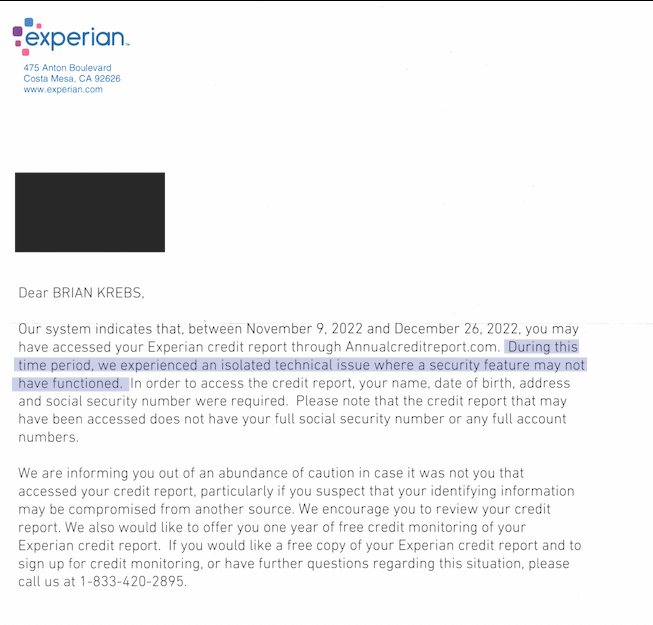
The tip about the Experian weakness came from Jenya Kushnir, a security researcher living in Ukraine who said he discovered the method being used by identity thieves after spending time on Telegram chat channels dedicated to cybercrime.
Normally, Experian’s website will ask a series of multiple-choice questions about one’s financial history, as a way of validating the identity of the person requesting the credit report. But Kushnir said the crooks learned they could bypass those questions and trick Experian into giving them access to anyone’s credit report, just by editing the address displayed in the browser URL bar at a specific point in Experian’s identity verification process.
When I tested Kushnir’s instructions on my own identity at Experian, I found I was able to see my report even though Experian’s website told me it didn’t have enough information to validate my identity. A security researcher friend who tested it at Experian found she also could bypass Experian’s four or five multiple-choice security questions and go straight to her full credit report at Experian.
Experian acknowledged receipt of my Dec. 23 report four days later on Dec. 27, a day after Kushnir’s method stopped working on Experian’s website (the exploit worked as long as you came to Experian’s website via annualcreditreport.com — the site mandated to provide a free copy of your credit report from each of the major bureaus once a year).
Experian never did respond to official requests for comment on that story. But earlier this week, I received an otherwise unhelpful letter via snail mail from Experian (see image above), which stated that the weakness we reported persisted between Nov. 9, 2022 and Dec. 26, 2022.
“During this time period, we experienced an isolated technical issue where a security feature may not have functioned,” Experian explained.
It’s not entirely clear whether Experian sent me this paper notice because they legally had to, or if they felt I deserved a response in writing and thought maybe they’d kill two birds with one stone. But it’s pretty crazy that it took them a full month to notify me about the potential impact of a security failure that I notified them about.
It’s also a little nuts that Experian didn’t simply include a copy of my current credit report along with this letter, which is confusingly worded and reads like they suspect someone other than me may have been granted access to my credit report without any kind of screening or authorization.
After all, if I hadn’t authorized the request for my credit file that apparently prompted this letter (I had), that would mean the thieves already had my report. Shouldn’t I be granted the same visibility into my own credit file as them?
Instead, their woefully inadequate letter once again puts the onus on me to wait endlessly on hold for an Experian representative over the phone, or sign up for a free year’s worth of Experian monitoring my credit report.
As it stands, using Kushnir’s exploit was the only time I’ve ever been able to get Experian’s website to cough up a copy of my credit report. To make matters worse, a majority of the information in that credit report is not mine. So I’ve got that to look forward to.
If there is a silver lining here, I suppose that if I were Experian, I probably wouldn’t want to show Brian Krebs his credit file either. Because it’s clear this company has no idea who I really am. And in a weird, kind of sad way I guess, that makes me happy.
For thoughts on what you can do to minimize your victimization by and overall worth to the credit bureaus, see this section of the most recent Experian story.




T-Mobile today disclosed a data breach affecting tens of millions of customer accounts, its second major data exposure in as many years. In a filing with federal regulators, T-Mobile said an investigation determined that someone abused its systems to harvest subscriber data tied to approximately 37 million current customer accounts.

Image: customink.com
In a filing today with the U.S. Securities and Exchange Commission, T-Mobile said a “bad actor” abused an application programming interface (API) to hoover up data on roughly 37 million current postpaid and prepaid customer accounts. The data stolen included customer name, billing address, email, phone number, date of birth, T-Mobile account number, as well as information on the number of customer lines and plan features.
APIs are essentially instructions that allow applications to access data and interact with web databases. But left improperly secured, these APIs can be leveraged by malicious actors to mass-harvest information stored in those databases. In October, mobile provider Optus disclosed that hackers abused a poorly secured API to steal data on 10 million customers in Australia.
T-Mobile said it first learned of the incident on Jan. 5, 2023, and that an investigation determined the bad actor started abusing the API beginning around Nov. 25, 2022. The company says it is in the process of notifying affected customers, and that no customer payment card data, passwords, Social Security numbers, driver’s license or other government ID numbers were exposed.
In August 2021, T-Mobile acknowledged that hackers made off with the names, dates of birth, Social Security numbers and driver’s license/ID information on more than 40 million current, former or prospective customers who applied for credit with the company. That breach came to light after a hacker began selling the records on a cybercrime forum.
Last year, T-Mobile agreed to pay $500 million to settle all class action lawsuits stemming from the 2021 breach. The company pledged to spend $150 million of that money toward beefing up its own cybersecurity.
In its filing with the SEC, T-Mobile suggested it was going to take years to fully realize the benefits of those cybersecurity improvements, even as it claimed that protecting customer data remains a top priority.
“As we have previously disclosed, in 2021, we commenced a substantial multi-year investment working with leading external cybersecurity experts to enhance our cybersecurity capabilities and transform our approach to cybersecurity,” the filing reads. “We have made substantial progress to date, and protecting our customers’ data remains a top priority.”
Despite this being the second major customer data spill in as many years, T-Mobile told the SEC the company does not expect this latest breach to have a material impact on its operations.
While that may seem like a daring thing to say in a data breach disclosure affecting a significant portion of your active customer base, consider that T-Mobile reported revenues of nearly $20 billion in the third quarter of 2022 alone. In that context, a few hundred million dollars every couple of years to make the class action lawyers go away is a drop in the bucket.
The settlement related to the 2021 breach says T-Mobile will make $350 million available to customers who file a claim. But here’s the catch: If you were affected by that 2021 breach and you haven’t filed a claim yet, please know that you have only three more days to do that.
If you were a T-Mobile customer affected by the 2021 incident, it is likely that T-Mobile has already made several efforts to notify you of your eligibility to file a claim, which includes a payout of at least $25, with the possibility of more for those who can document direct costs associated with the breach. OpenClassActions.com says the filing deadline is Jan. 23, 2023.
“If you opt for a cash payment you will receive an estimated $25.00,” the site explains. “If you reside in California, you will receive an estimated $100.00. Out of pocket losses can be reimbursed for up to $25,000.00. The amount that you claim from T-Mobile will be determined by the class action administrator based on how many people file a legitimate and timely claim form.”
There are currently no signs that hackers are selling this latest data haul from T-Mobile, but if the past is any teacher much of it will wind up posted online soon. It is a safe bet that scammers will use some of this information to target T-Mobile users with phishing messages, account takeovers and harassment.
T-Mobile customers should fully expect to see phishers taking advantage of public concern over the breach to impersonate the company — and possibly even send messages that include the recipient’s compromised account details to make the communications look more legitimate.
Data stolen and exposed in this breach may also be used for identity theft. Credit monitoring and ID theft protection services can help you recover from having your identity stolen, but most will do nothing to stop the ID theft from happening. If you want the maximum control over who should be able to view your credit or grant new lines of credit in your name, then a security freeze is your best option.
Regardless of which mobile provider you patronize, please consider removing your phone number from as many online accounts as you can. Many online services require you to provide a phone number upon registering an account, but in many cases that number can be removed from your profile afterwards.
Why do I suggest this? Many online services allow users to reset their passwords just by clicking a link sent via SMS, and this unfortunately widespread practice has turned mobile phone numbers into de facto identity documents. Which means losing control over your phone number thanks to an unauthorized SIM swap or mobile number port-out, divorce, job termination or financial crisis can be devastating.
When the Internet Engineering Task Force (IETF) announced the TLS 1.3 standard in RFC 8446 in August 2018, plenty of tools and utilities were already supporting it (even as early as the year prior, some web browsers had implemented it as their default standard, only having to roll it back due to compatibility issues. Needless to say, the rollout was not perfect).
Toward the end of 2018, EMA conducted a survey of customers regarding their TLS 1.3 implementation and migration plans. In the January 2019 report, EMA concluded:
Some participants’ organizations may find they have to go back to the drawing board and come up with a Plan B to enable TLS 1.3 without losing visibility, introducing unacceptable performance bottlenecks and greatly increasing operational overhead. Whether they feel they have no choice but to enable TLS 1.3 because major web server and browser vendors have already pushed ahead with it or because they need to keep pace with the industry as it embraces the new standard is unclear. What is clear is that security practitioners see the new standard as offering greater privacy and end-to-end data security for their organizations, and that the long wait for its advancement is over.
When EMA asked many of the same questions in an updated survey of 204 technology and business leaders toward the end of 2022, they found that nearly all the conclusions in the 2018/2019 report still hold true today. Here are the three biggest takeaways from this most recent survey:
While regulatory frameworks and vendor controls continue to push the adoption of the TLS 1.3 standard, adoption still comes with a significant price tag – one that many organizations are just not yet ready or able to consume. Technology improvements will increase rates of adoption over time, such as Cisco Secure Firewall’s ability to decrypt and inspect encrypted traffic. More recent and unique technologies, like Cisco’s encrypted visibility engine, allow the firewall to recognize attack patterns in encrypted traffic without decryption. This latter functionality preserves performance and privacy of the encrypted flows without sacrificing the visibility and monitoring that 94% of respondents were concerned about.
Readers wishing to read the full EMA report can do so here and readers wishing to learn more about Cisco Secure Firewall’s encyrpted visibility engine can do so here.
We’d love to hear what you think. Ask a Question, Comment Below, and Stay Connected with Cisco Secure on social!
Cisco Secure Social Channels
Most people who operate DDoS-for-hire businesses attempt to hide their true identities and location. Proprietors of these so-called “booter” or “stresser” services — designed to knock websites and users offline — have long operated in a legally murky area of cybercrime law. But until recently, their biggest concern wasn’t avoiding capture or shutdown by the feds: It was minimizing harassment from unhappy customers or victims, and insulating themselves against incessant attacks from competing DDoS-for-hire services.
And then there are booter store operators like John Dobbs, a 32-year-old computer science graduate student living in Honolulu, Hawaii. For at least a decade until late last year, Dobbs openly operated IPStresser[.]com, a popular and powerful attack-for-hire service that he registered with the state of Hawaii using his real name and address. Likewise, the domain was registered in Dobbs’s name and hometown in Pennsylvania.

Dobbs, in an undated photo from his Github profile. Image: john-dobbs.github.io
The only work experience Dobbs listed on his resume was as a freelance developer from 2013 to the present day. Dobbs’s resume doesn’t name his booter service, but in it he brags about maintaining websites with half a million page views daily, and “designing server deployments for performance, high-availability and security.”
In December 2022, the U.S. Department of Justice seized Dobbs’s IPStresser website and charged him with one count of aiding and abetting computer intrusions. Prosecutors say his service attracted more than two million registered users, and was responsible for launching a staggering 30 million distinct DDoS attacks.
The government seized four-dozen booter domains, and criminally charged Dobbs and five other U.S. men for allegedly operating stresser services. This was the Justice Department’s second such mass takedown targeting DDoS-for-hire services and their accused operators. In 2018, the feds seized 15 stresser sites, and levied cybercrime charges against three men for their operation of booter services.

Dobbs’s booter service, IPStresser, in June 2020. Image: archive.org.
Many accused stresser site operators have pleaded guilty over the years after being hit with federal criminal charges. But the government’s core claim — that operating a booter site is a violation of U.S. computer crime laws — wasn’t properly tested in the courts until September 2021.
That was when a jury handed down a guilty verdict against Matthew Gatrel, a then 32-year-old St. Charles, Ill. man charged in the government’s first 2018 mass booter bust-up. Despite admitting to FBI agents that he ran two booter services (and turning over plenty of incriminating evidence in the process), Gatrel opted to take his case to trial, defended the entire time by court-appointed attorneys.
Prosecutors said Gatrel’s booter services — downthem[.]org and ampnode[.]com — helped some 2,000 paying customers launch debilitating digital assaults on more than 20,000 targets, including many government, banking, university and gaming websites.
Gatrel was convicted on all three charges of violating the Computer Fraud and Abuse Act, including conspiracy to commit unauthorized impairment of a protected computer, conspiracy to commit wire fraud, and unauthorized impairment of a protected computer. He was sentenced to two years in prison.
Now, it appears Dobbs is also planning to take his chances with a jury. On Jan. 4, Dobbs entered a plea of not guilty. Neither Dobbs nor his court-appointed attorney responded to requests for comment.
But as it happens, Dobbs himself provided some perspective on his thinking in an email exchange with KrebsOnSecurity back in 2020. I’d reached out to Dobbs because it was obvious he didn’t mind if people knew he operated one of the world’s most popular DDoS-for-hire sites, and I was genuinely curious why he was so unafraid of getting raided by the feds.
“Yes, I am the owner of the domain you listed, however you are not authorized to post an article containing said domain name, my name or this email address without my prior written permission,” Dobbs replied to my initial outreach on March 10, 2020 using his email address from the University of Hawaii at Manoa.
A few hours later, I received more strident instructions from Dobbs, this time via his official email address at ipstresser[.]com.
“I will state again for absolute clarity, you are not authorized to post an article containing ipstresser.com, my name, my GitHub profile and/or my hawaii.edu email address,” Dobbs wrote, as if taking dictation from a lawyer who doesn’t understand how the media works.
When pressed for particulars on his business, Dobbs replied that the number of IPStresser customers was “privileged information,” and said he didn’t even advertise the service. When asked whether he was concerned that many of his competitors were by then serving jail time for operating similar booter services, Dobbs maintained that the way he’d set up the business insulated him from any liability.
“I have been aware of the recent law enforcement actions against other operators of stress testing services,” Dobbs explained. “I cannot speak to the actions of these other services, but we take proactive measures to prevent misuse of our service and we work with law enforcement agencies regarding any reported abuse of our service.”
What were those proactive measures? In a 2015 interview with ZDNet France, Dobbs asserted that he was immune from liability because his clients all had to submit a digital signature attesting that they wouldn’t use the site for illegal purposes.
“Our terms of use are a legal document that protects us, among other things, from certain legal consequences,” Dobbs told ZDNet. “Most other sites are satisfied with a simple checkbox, but we ask for a digital signature in order to imply real consent from our customers.”
Dobbs told KrebsOnSecurity his service didn’t generate much of a profit, but rather that he was motivated by “filling a legitimate need.”
“My reason for offering the service is to provide the ability to test network security measures before someone with malicious intent attacks said network and causes downtime,” he said. “Sure, some people see only the negatives, but there is a long list of companies I have worked with over the years who would say my service is a godsend and has helped them prevent tens of thousands of dollars in downtime resulting from a malicious attack.”
“I do not believe that providing such a service is illegal, assuming proper due diligence to prevent malicious use of the service, as is the case for IPstresser[.]com,” Dobbs continued. “Someone using such a service to conduct unauthorized testing is illegal in many countries, however, the legal liability is that of the user, not of the service provider.”
Dobbs’s profile on GitHub includes more of his ideas about his work, including a curious piece on “software engineering ethics.” In his January 2020 treatise “My Software Engineering Journey,” Dobbs laments that nothing in his formal education prepared him for the reality that a great deal of his work would be so tedious and repetitive (this tracks closely with a 2020 piece here called Career Choice Tip: Cybercrime is Mostly Boring).
“One area of software engineering that I think should be covered more in university classes is maintenance,” Dobbs wrote. “Projects are often worked on for at most a few months, and students do not experience the maintenance aspect of software engineering until they reach the workplace. Let’s face it, ongoing maintenance of a project is boring; there is nothing like the euphoria of completing a project you have been working on for months and releasing it to the world, but I would say that half of my professional career has been related to maintenance.”
Allison Nixon is chief research officer at the New York-based cybersecurity firm Unit 221B. Nixon is part of a small group of researchers who have been closely tracking the DDoS-for-hire industry for years, and she said Dobbs’s claim that what he’s doing is legal makes sense given that it took years for the government to recognize the size of the problem.
“These guys are arguing that their services are legal because for a long time nothing happened to them,” Nixon said. “It’s difficult to argue something is illegal if no one has ever been arrested for it before.”
Nixon says the government’s fight against the booter services — and by extension other types of cybercrimes — is hampered by a legal system that often takes years to cycle through cybercrime cases.
“With cybercrime, the cycle between the crime and investigation and arrest can often take a year or more, and that’s for a really fast case,” Nixon said. “If someone robbed a store, we’d expect a police response within a few minutes. If someone robs a bank’s website, there might be some indication of police activity within a year.”
Nixon praised the 2022 and 2018 booter takedown operations as “huge steps forward,” but added that “there need to be more of them, and faster.”
“This time lag is part of the reason it’s so difficult to shut down the pipeline of new talent going into cybercrime,” she said. “They think what they’re doing is legal because nothing has happened, and because of the amount of time it takes to shut these things down. And it’s really a big problem, where we see a lot of people becoming criminals on the basis that what they’re doing isn’t really illegal because the cops won’t do anything.”
In December 2020, Dobbs filed an application with the state of Hawaii to withdraw IP Stresser Inc. from its roster of active companies. But according to prosecutors, Dobbs would continue to operate his DDoS-for-hire site until at least November 2022.
Two months after our 2020 email interview, Dobbs would earn his second bachelor’s degree (in computer science; his resume says he earned a bachelor’s in civil engineering from Drexel University in 2013). The federal charges against Dobbs came just as he was preparing to enter his final semester toward a master’s degree in computer science at the University of Hawaii.
Nixon says she has a message for anyone involved in operating a DDoS-for-hire service.
“Unless you are verifying that the target owns the infrastructure you’re targeting, there is no legal way to operate a DDoS-for-hire service,” she said. “There is no Terms of Service you could put on the site that would somehow make it legal.”
And her message to the customers of those booter services? It’s a compelling one to ponder, particularly now that investigators in the United States, U.K. and elsewhere have started going after booter service customers.
“When a booter service claims they don’t share logs, they’re lying because logs are legal leverage for when the booter service operator gets arrested,” Nixon said. “And when they do, you’re going to be the first people they throw under the bus.”
As the majority of the global Covid fog finally started lifting in 2022, other events – and their associated risks – started to fill the headspace of C-level execs the world over. In my role, I regularly engage with CISOs in all kinds of sectors, representatives at industry bodies, and experts at analyst houses. This gives me an invaluable macroview not only of how the last 12 months have affected organizations and what CISOs are thinking about, but also how the upcoming year is shaping up.
Using this information, last year I wrote a blog summing up the nine top of mind issues I believed will most impact CISOs as we headed into 2022. Many of them still ring true now and will continue to do so, but some new concerns have risen up the agenda. Here are the topics that I think will be top of mind in 2023, and what CISOs can do to prepare.
One aspect that has come to the fore this year is the CISO’s position as ‘guardian of customers’ private data’ in the event of a breach, and their responsibilities over the level of disclosure they later provide. And here, we are not only talking about the legal duty to inform regulators, but the implicit moral duty to inform third parties, customers, etc. From my conversations this year, this whole area is getting CISOs thinking about their own personal liability more.
As a result of this, next year we could see CISOs tightening up the disclosure decision making process, focusing on quicker and greater clarity on breach impact, and even looking to include personal liability cover in cyber insurance contracts. CISOs will also likely be pushing more tabletop exercises with the executive leadership team to ask and answer questions around what is showed, to whom, and by whom.
Cyber insurance has become a newsworthy topic over the last 24 months, mainly due to the hardening of the market, as insurance products have become less profitable for underwriters and insurers’ costs have risen. But the topic will continue to be in focus as we move into 2023, with insurers demanding greater attribution – aka the science of identifying the perpetrator of a cybercrime by comparing the evidence gathered from an attack with evidence gathered from earlier attacks that have been attributed to known perpetrators to find similarities.
The need for greater attribution stems from the news that some insurers are announcing that they are not covering nation state attacks, including major marketplace for insurance and reinsurance, Lloyd’s – a topic I covered with colleague and co-author Martin Lee, in this blog earlier in the year.
Greater preparation and crystal-clear clarity of the extent to which attribution has taken place when negotiating contracts will be an essential element for CISOs going forward. For more practical advice on this topic, I also wrote a blog on some of the challenges and opportunities within the cyber liability insurance market back in June which you can read here.
Being a CISO has never been more complex. With more sophisticated attacks, scarcity of resources, the challenges of communicating effectively with the board, and more demanding regulatory drivers like the recently approved NIS2 in the EU, which includes a requirement to flag incidents that cause a significant financial implication or operational disruption to the service or to others within 24 hours.
With so much to consider, it is vital that CISOs have a clear understanding of the core elements of what they protect. Questions like ‘where is the data?’, ‘who is accessing it?’, ‘what applications is the organization using?’, ‘where and what is in the cloud?’ will continue to be asked, with an overarching need to make management of the security function more flexible and simpler for the user. This visibility will also inevitably help ease quicker decision making and less of an operational overhead when it comes to regulatory compliance, so the benefits of asking these questions are clear.
According to Forrester, the term Zero Trust was born in 2009. Since then, it has been used liberally by different cybersecurity vendors – with various degrees of accuracy. Zero Trust implementations, while being the most secure approach a firm can take, are long journeys that take multiple years for major enterprises to carry out, so it is vital that they start as they mean to go on. But it is clear from the interactions we have had that many CISOs still don’t know where to start, as we touched on in point #3.
However, that can be easier said than done in many cases, as the principles within Zero trust fundamentally turn traditional security methods on their head, from protecting from the outside in (guarding your company’s parameter from external threats) to protecting from in the inside out (guarding individual assets from all threats, both internal and external). This is particularly challenging for large enterprises with a multitude of different silos, stakeholders and business divisions to consider.
The key to success on a zero-trust journey is to set up the right governance mode with the relevant stakeholders and communicate all changes. It is also worth taking the opportunity to update their solutions via a tech refresh which has a multitude of benefits, as explained in our most recent Security Outcomes Study (volume 2).
For more on where to start check out our eBook which explores the five phases to achieving zero trust, and if you have already embarked on the journey, read our recently published Guide to Zero Trust Maturity to help you find quick wins along the way.
As with last year, ransomware continues to be the main tactical issue and concern facing CISOs. More specifically, the uncertainty around when and how an attack could be launched against the organization is a constant threat.
Increased regulation on the payment of ransomware and declaring payments is predicted, on top of the Cyber Incident Reporting for Critical Infrastructure Act of 2022 (CIRCIA), the Ransom Disclosure Act, but that doesn’t help alleviate ransomware worries, especially as this will again put the CISO in the firing line.
CISOs will continue to keep a focus on the core basics to prevent or limit the impact of an attack, and again have a closer look at how any ransomware payment may or may not be paid and who will authorize payment. For more on how executives can prepare for ransomware attacks, read this blog from Cisco Talos.
Traditionally CISOs have talked about the importance of improving security awareness which has resulted in the growth of those test phishing emails we all know and love so much. Joking aside, there is increased discussion now about the limited impact of this approach, including this in depth study from the computer science department of ETH Zurich.
The study, which was the largest both in terms of scale and length at time of publishing, revealed that ‘embedded training during simulated phishing exercises, as commonly deployed in the industry today, does not make employees more resilient to phishing, but instead it can have unexpected side effects that can make employees even more susceptible to phishing’.
For the most effective security awareness, culture is key. This means that everyone should see themselves as part of the security team, like the approach that has been taken when approaching the issue of safety in many high-risk industries. In 2023, CISOs will now be keen to bring about a change to a security culture by making security inclusive, looking to create security champions within the business unit, and finding new methods to communicate the security message.
Last year, we talked about preparing for the ‘great resignation’ and how to prevent staff leaving as WFH became a norm rather than an exception. In the past year, the conversations I have had have altered to focus on how to ensure recruitment and retention of key staff within the business by ensuring they work in an environment that supports their role.
Overly restrictive security practices, burdensome security with too many friction points, and limitations around what resources and tools can be used may deter the best talent from joining – or indeed staying – with an organization. And CISOs don’t need that extra worry of being the reason behind that kind of ‘brain drain’. So, security will need to focus on supporting the introduction of flexibility and the ease of user experience, such as passwordless or risk-based authentication.
Just when we thought it was safe to go back into the organization with MFA protecting us, along came methods of attack that rely on push-based authentication vulnerabilities including:
There has been a lot written about this kind of technique and how it works (including guidance from Duo) due to some recent high-profile cases. So, in the forthcoming year CISOs will look to update their solutions and introduce new ways to authenticate, along with increased communications to users on the topic.
This issue was highlighted again this year driven by regulations in different sectors such as the UK Telecoms (Security) Act which went live in the UK in November 2022 and the new EU regulation on digital operational resilience for financial services firms (DORA), which the European Parliament voted to adopt, also in November 2022. Both prompt greater focus on compliance, more reporting and understanding the dependency and interaction organizations have with the supply chain and other third parties.
CISOs will focus on obtaining reassurance from third parties as to their posture and will receive a lot of requests from others about where their organization stands, so it is crucial more robust insight into third parties is gained, documented, and communicated.
When writing this blog, and comparing it to last year’s, the 2023 top nine topics fit into three categories. Some themes make a reappearance, seem to repeat themselves such as the need to improve security’s interaction with users and the need to keep up to date with digital change. Others appear as almost incremental changes to current capabilities such as an adjusted approach to MFA to cope with push fatigue. But, perhaps one of the most striking differences to previous years is the new focus on the role of the CISO in the firing line and the personal impact that may have. We will of course continue to monitor all changes over the year and lend our viewpoint to give guidance. We wish you a secure and prosperous new year!
We’d love to hear what you think. Ask a Question, Comment Below, and Stay Connected with Cisco Secure on social!
Cisco Secure Social Channels
Microsoft today released updates to fix nearly 100 security flaws in its Windows operating systems and other software. Highlights from the first Patch Tuesday of 2023 include a zero-day vulnerability in Windows, printer software flaws reported by the U.S. National Security Agency, and a critical Microsoft SharePoint Server bug that allows a remote, unauthenticated attacker to make an anonymous connection.

At least 11 of the patches released today are rated “Critical” by Microsoft, meaning they could be exploited by malware or malcontents to seize remote control over vulnerable Windows systems with little or no help from users.
Of particular concern for organizations running Microsoft SharePoint Server is CVE-2023-21743. This is a Critical security bypass flaw that could allow a remote, unauthenticated attacker to make an anonymous connection to a vulnerable SharePoint server. Microsoft says this flaw is “more likely to be exploited” at some point.
But patching this bug may not be as simple as deploying Microsoft updates. Dustin Childs, head of threat awareness at Trend Micro’s Zero Day Initiative, said sysadmins need to take additional measures to be fully protected from this vulnerability.
“To fully resolve this bug, you must also trigger a SharePoint upgrade action that’s also included in this update,” Childs said. “Full details on how to do this are in the bulletin. Situations like this are why people who scream ‘Just patch it!’ show they have never actually had to patch an enterprise in the real world.”
Eighty-seven of the vulnerabilities earned Redmond’s slightly less dire “Important” severity rating. That designation describes vulnerabilities “whose exploitation could result in compromise of the confidentiality, integrity, or availability of user data, or of the integrity or availability of processing resources.”
Among the more Important bugs this month is CVE-2023-21674, which is an “elevation of privilege” weakness in most supported versions of Windows that has already been abused in active attacks.
Satnam Narang, senior staff research engineer at Tenable, said although details about the flaw were not available at the time Microsoft published its advisory on Patch Tuesday, it appears this was likely chained together with a vulnerability in a Chromium-based browser such as Google Chrome or Microsoft Edge in order to break out of a browser’s sandbox and gain full system access.
“Vulnerabilities like CVE-2023-21674 are typically the work of advanced persistent threat (APT) groups as part of targeted attacks,” Narang said. “The likelihood of future widespread exploitation of an exploit chain like this is limited due to auto-update functionality used to patch browsers.”
By the way, when was the last time you completely closed out your Web browser and restarted it? Some browsers will automatically download and install new security updates, but the protection from those updates usually only happens after you restart the browser.
Speaking of APT groups, the U.S. National Security Agency is credited with reporting CVE-2023-21678, which is another “important” vulnerability in the Windows Print Spooler software.
There have been so many vulnerabilities patched in Microsoft’s printing software over the past year (including the dastardly PrintNightmare attacks and borked patches) that KrebsOnSecurity has joked about Patch Tuesday reports being sponsored by Print Spooler. Tenable’s Narang points out that this is the third Print Spooler flaw the NSA has reported in the last year.
Kevin Breen at Immersive Labs called special attention to CVE-2023-21563, which is a security feature bypass in BitLocker, the data and disk encryption technology built into enterprise versions of Windows.
“For organizations that have remote users, or users that travel, this vulnerability may be of interest,” Breen said. “We rely on BitLocker and full-disk encryption tools to keep our files and data safe in the event a laptop or device is stolen. While information is light, this appears to suggest that it could be possible for an attacker to bypass this protection and gain access to the underlying operating system and its contents. If security teams are not able to apply this patch, one potential mitigation could be to ensure Remote Device Management is deployed with the ability to remotely disable and wipe assets.”
There are also two Microsoft Exchange vulnerabilities patched this month — CVE-2023-21762 and CVE-2023-21745. Given the rapidity with which threat actors exploit new Exchange bugs to steal corporate email and infiltrate vulnerable systems, organizations using Exchange should patch immediately. Microsoft’s advisory says these Exchange flaws are indeed “more likely to be exploited.”
Adobe released four patches addressing 29 flaws in Adobe Acrobat and Reader, InDesign, InCopy, and Adobe Dimension. The update for Reader fixes 15 bugs with eight of these being ranked Critical in severity (allowing arbitrary code execution if an affected system opened a specially crafted file).
For a more granular rundown on the updates released today, see the SANS Internet Storm Center roundup. Nearly 100 updates is a lot, and there are bound to be a few patches that cause problems for organizations and end users. When that happens, AskWoody.com usually has the lowdown.
Please consider backing up your data and/or imaging your system before applying any updates. And please sound off in the comments if you experience any problems as a result of these patches.
Identity thieves have been exploiting a glaring security weakness in the website of Experian, one of the big three consumer credit reporting bureaus. Normally, Experian requires that those seeking a copy of their credit report successfully answer several multiple choice questions about their financial history. But until the end of 2022, Experian’s website allowed anyone to bypass these questions and go straight to the consumer’s report. All that was needed was the person’s name, address, birthday and Social Security number.

The vulnerability in Experian’s website was exploitable after one applied to see their credit file via annualcreditreport.com.
In December, KrebsOnSecurity heard from Jenya Kushnir, a security researcher living in Ukraine who said he discovered the method being used by identity thieves after spending time on Telegram chat channels dedicated to the cashing out of compromised identities.
“I want to try and help to put a stop to it and make it more difficult for [ID thieves] to access, since [Experian is] not doing shit and regular people struggle,” Kushnir wrote in an email to KrebsOnSecurity explaining his motivations for reaching out. “If somehow I can make small change and help to improve this, inside myself I can feel that I did something that actually matters and helped others.”
Kushnir said the crooks learned they could trick Experian into giving them access to anyone’s credit report, just by editing the address displayed in the browser URL bar at a specific point in Experian’s identity verification process.
Following Kushnir’s instructions, I sought a copy of my credit report from Experian via annualcreditreport.com — a website that is required to provide all Americans with a free copy of their credit report from each of the three major reporting bureaus, once per year.
Annualcreditreport.com begins by asking for your name, address, SSN and birthday. After I supplied that and told Annualcreditreport.com I wanted my report from Experian, I was taken to Experian.com to complete the identity verification process.
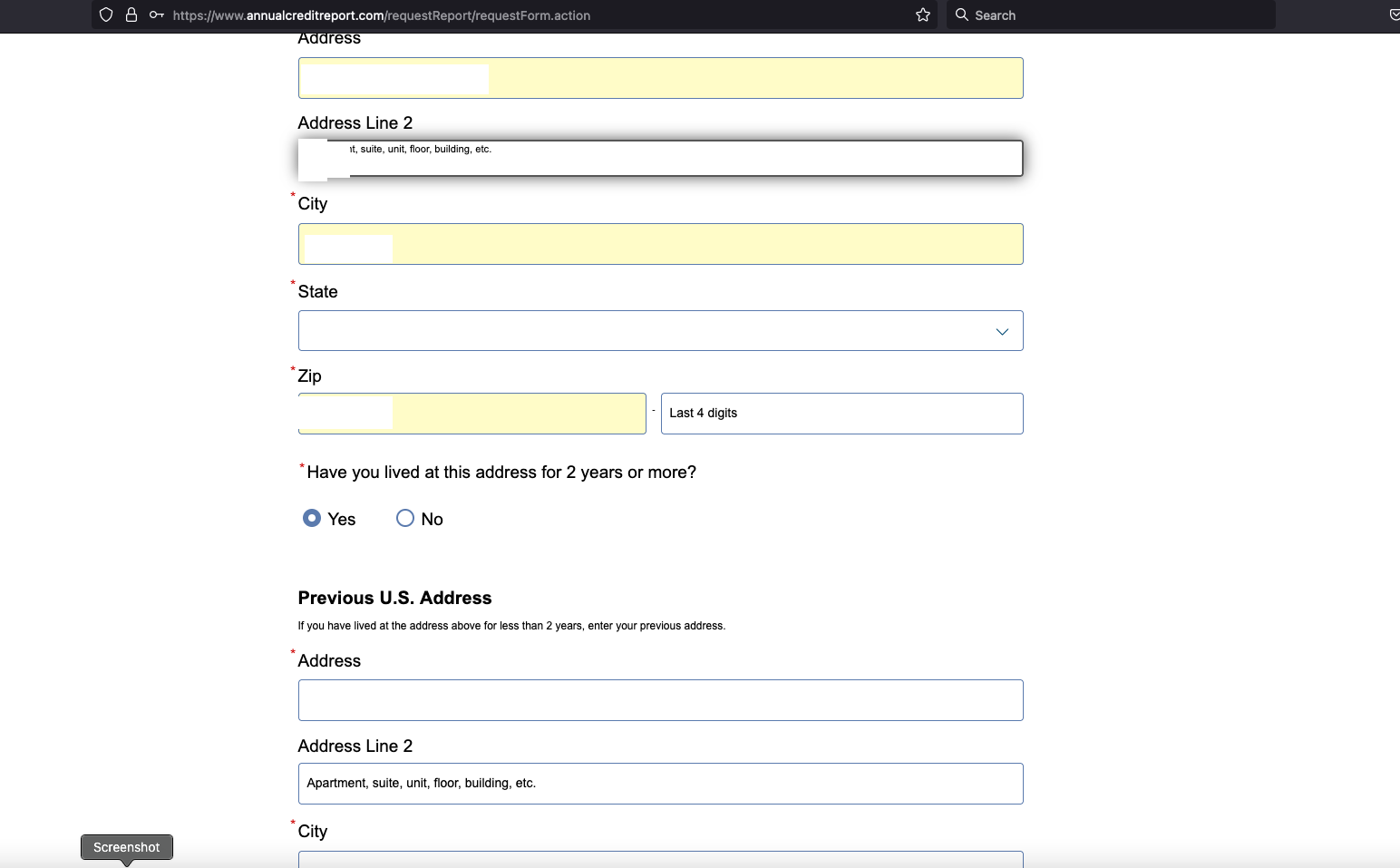
Normally at this point, Experian’s website would present four or five multiple-guess questions, such as “Which of the following addresses have you lived at?”
Kushnir told me that when the questions page loads, you simply change the last part of the URL from “/acr/oow/” to “/acr/report,” and the site would display the consumer’s full credit report.
But when I tried to get my report from Experian via annualcreditreport.com, Experian’s website said it didn’t have enough information to validate my identity. It wouldn’t even show me the four multiple-guess questions. Experian said I had three options for a free credit report at this point: Mail a request along with identity documents, call a phone number for Experian, or upload proof of identity via the website.
But that didn’t stop Experian from showing me my full credit report after I changed the Experian URL as Kushnir had instructed — modifying the error page’s trailing URL from “/acr/OcwError” to simply “/acr/report”.
Experian’s website then immediately displayed my entire credit file.
Even though Experian said it couldn’t tell that I was actually me, it still coughed up my report. And thank goodness it did. The report contains so many errors that it’s probably going to take a good deal of effort on my part to straighten out.
Now I know why Experian has NEVER let me view my own file via their website. For example, there were four phone numbers on my Experian credit file: Only one of them was mine, and that one hasn’t been mine for ages.
I was so dumbfounded by Experian’s incompetence that I asked a close friend and trusted security source to try the method on her identity file at Experian. Sure enough, when she got to the part where Experian asked questions, changing the last part of the URL in her address bar to “/report” bypassed the questions and immediately displayed her full credit report. Her report also was replete with errors.
KrebsOnSecurity shared Kushnir’s findings with Experian on Dec. 23, 2022. On Dec. 27, 2022, Experian’s PR team acknowledged receipt of my Dec. 23 notification, but the company has so far ignored multiple requests for comment or clarification.
By the time Experian confirmed receipt of my report, the “exploit” Kushnir said he learned from the identity thieves on Telegram had been patched and no longer worked. But it remains unclear how long Experian’s website was making it so easy to access anyone’s credit report.
In response to information shared by KrebsOnSecurity, Senator Ron Wyden (D-Ore.) said he was disappointed — but not at all surprised — to hear about yet another cybersecurity lapse at Experian.
“The credit bureaus are poorly regulated, act as if they are above the law and have thumbed their noses at Congressional oversight,” Wyden said in a written statement. “Just last year, Experian ignored repeated briefing requests from my office after you revealed another cybersecurity lapse the company.”
Sen. Wyden’s quote above references a story published here in July 2022, which broke the news that identity thieves were hijacking consumer accounts at Experian.com just by signing up as them at Experian once more, supplying the target’s static, personal information (name, DoB/SSN, address) but a different email address.
From interviews with multiple victims who contacted KrebsOnSecurity after that story, it emerged that Experian’s own customer support representatives were actually telling consumers who got locked out of their Experian accounts to recreate their accounts using their personal information and a new email address. This was Experian’s advice even for people who’d just explained that this method was what identity thieves had used to lock them in out in the first place.
Clearly, Experian found it simpler to respond this way, rather than acknowledging the problem and addressing the root causes (lazy authentication and abhorrent account recovery practices). It’s also worth mentioning that reports of hijacked Experian.com accounts persisted into late 2022. That screw-up has since prompted a class action lawsuit against Experian.
Sen. Wyden said the Federal Trade Commission (FTC) and Consumer Financial Protection Bureau (CFPB) need to do much more to protect Americans from screw-ups by the credit bureaus.
“If they don’t believe they have the authority to do so, they should endorse legislation like my Mind Your Own Business Act, which gives the FTC power to set tough mandatory cybersecurity standards for companies like Experian,” Wyden said.
Sadly, none of this is terribly shocking behavior for Experian, which has shown itself a completely negligent custodian of obscene amounts of highly sensitive consumer information.
In April 2021, KrebsOnSecurity revealed how identity thieves were exploiting lax authentication on Experian’s PIN retrieval page to unfreeze consumer credit files. In those cases, Experian failed to send any notice via email when a freeze PIN was retrieved, nor did it require the PIN to be sent to an email address already associated with the consumer’s account.
A few days after that April 2021 story, KrebsOnSecurity broke the news that an Experian API was exposing the credit scores of most Americans.
It’s bad enough that we can’t really opt out of companies like Experian making $2.6 billion each quarter collecting and selling gobs of our personal and financial information. But there has to be some meaningful accountability when these monopolistic companies engage in negligent and reckless behavior with the very same consumer data that feeds their quarterly profits. Or when security and privacy shortcuts are found to be intentional, like for cost-saving reasons.
And as we saw with Equifax’s consolidated class-action settlement in response to letting state-sponsored hackers from China steal data on nearly 150 million Americans back in 2017, class-actions and more laughable “free credit monitoring” services from the very same companies that created the problem aren’t going to cut it.
It is easy to adopt a defeatist attitude with the credit bureaus, who often foul things up royally even for consumers who are quite diligent about watching their consumer credit files and disputing any inaccuracies.
But there are some concrete steps that everyone can take which will dramatically lower the risk that identity thieves will ruin your financial future. And happily, most of these steps have the side benefit of costing the credit bureaus money, or at least causing the data they collect about you to become less valuable over time.
The first step is awareness. Find out what these companies are saying about you behind your back. Keep in mind that — fair or not — your credit score as collectively determined by these bureaus can affect whether you get that loan, apartment, or job. In that context, even small, unintentional errors that are unrelated to identity theft can have outsized consequences for consumers down the road.
Each bureau is required to provide a free copy of your credit report every year. The easiest way to get yours is through annualcreditreport.com.
Some consumers report that this site never works for them, and that each bureau will insist they don’t have enough information to provide a report. I am definitely in this camp. Thankfully, a financial institution that I already have a relationship with offers the ability to view your credit file through them. Your mileage on this front may vary, and you may end up having to send copies of your identity documents through the mail or website.
When you get your report, look for anything that isn’t yours, and then document and file a dispute with the corresponding credit bureau. And after you’ve reviewed your report, set a calendar reminder to recur every four months, reminding you it’s time to get another free copy of your credit file.
If you haven’t already done so, consider making 2023 the year that you freeze your credit files at the three major reporting bureaus, including Experian, Equifax and TransUnion. It is now free to people in all 50 U.S. states to place a security freeze on their credit files. It is also free to do this for your partner and/or your dependents.
Freezing your credit means no one who doesn’t already have a financial relationship with you can view your credit file, making it unlikely that potential creditors will grant new lines of credit in your name to identity thieves. Freezing your credit file also means Experian and its brethren can no longer sell peeks at your credit history to others.
Anytime you wish to apply for new credit or a new job, or open an account at a utility or communications provider, you can quickly thaw a freeze on your credit file, and set it to freeze automatically again after a specified length of time.
Please don’t confuse a credit freeze (a.k.a. “security freeze”) with the alternative that the bureaus will likely steer you towards when you ask for a freeze: “Credit lock” services.
The bureaus pitch these credit lock services as a way for consumers to easily toggle their credit file availability with push of a button on a mobile app, but they do little to prevent the bureaus from continuing to sell your information to others.
My advice: Ignore the lock services, and just freeze your credit files already.
One final note. Frequent readers here will have noticed that I’ve criticized these so-called “knowledge-based authentication” or KBA questions that Experian’s website failed to ask as part of its consumer verification process.
KrebsOnSecurity has long assailed KBA as weak authentication because the questions and answers are drawn largely from consumer records that are public and easily accessible to organized identity theft groups.
That said, given that these KBA questions appear to be the ONLY thing standing between me and my Experian credit report, it seems like maybe they should at least take care to ensure that those questions actually get asked.




Microsoft has released its final monthly batch of security updates for 2022, fixing more than four dozen security holes in its various Windows operating systems and related software. The most pressing patches include a zero-day in a Windows feature that tries to flag malicious files from the Web, a critical bug in PowerShell, and a dangerous flaw in Windows 11 systems that was detailed publicly prior to this week’s Patch Tuesday.

The security updates include patches for Azure, Microsoft Edge, Office, SharePoint Server, SysInternals, and the .NET framework. Six of the update bundles earned Microsoft’s most dire “critical” rating, meaning they fix vulnerabilities that malware or malcontents can use to remotely commandeer an unpatched Windows system — with little to no interaction on the part of the user.
The bug already seeing exploitation is CVE-2022-44698, which allows attackers to bypass the Windows SmartScreen security feature. The vulnerability allows attackers to craft documents that won’t get tagged with Microsoft’s “Mark of the Web,” despite being downloaded from untrusted sites.
“This means no Protected View for Microsoft Office documents, making it easier to get users to do sketchy things like execute malicious macros, said Greg Wiseman, product manager at security firm Rapid7. This is the second Mark of the Web flaw Microsoft has patched in as many months; both were first publicly detailed over the past two months on Twitter by security researcher Will Dormann.
Publicly disclosed (but not actively exploited for now) is CVE-2022-44710, which is an elevation of privilege flaw in the DirectX graphics component of Windows 11.
Another notable critical bug is CVE-2022-41076, a remote code execution flaw in PowerShell — a key component of Windows that makes it easier to automate system tasks and configurations.
Kevin Breen at Immersive Labs said while Microsoft doesn’t share much detail about CVE-2022-41076 apart from the designation ‘Exploitation More Likely,’ they also note that successful exploitation requires an attacker to take additional actions to prepare the target environment.
“What actions are required is not clear; however, we do know that exploitation requires an authenticated user level of access,” Breen said. “This combination suggests that the exploit requires a social engineering element, and would likely be seen in initial infections using attacks like MalDocs or LNK files.”
Speaking of malicious documents, Trend Micro’s Zero Day Initiative highlights CVE-2022-44713, a spoofing vulnerability in Outlook for Mac.
“We don’t often highlight spoofing bugs, but anytime you’re dealing with a spoofing bug in an e-mail client, you should take notice,” ZDI’s Dustin Childs wrote. “This vulnerability could allow an attacker to appear as a trusted user when they should not be. Now combine this with the SmartScreen Mark of the Web bypass and it’s not hard to come up with a scenario where you receive an e-mail that appears to be from your boss with an attachment entitled “Executive_Compensation.xlsx”. There aren’t many who wouldn’t open that file in that scenario.”
Microsoft also released guidance on reports that certain software drivers certified by Microsoft’s Windows Hardware Developer Program were being used maliciously in post-exploitation activity.
Three different companies reported evidence that malicious hackers were using these signed malicious driver files to lay the groundwork for ransomware deployment inside victim organizations. One of those companies, Sophos, published a blog post Tuesday detailing how the activity was tied to the Russian ransomware group Cuba, which has extorted an estimated $60 million from victims since 2019.
Of course, not all scary and pressing security threats are Microsoft-based. Also on Tuesday, Apple released a bevy of security updates to iOS, iPadOS, macOS, tvOS and Safari, including a patch for a newly discovered zero-day vulnerability that could lead to remote code execution.
Anyone responsible for maintaining Fortinet or Citrix remote access products probably needs to update, as both are dealing with active attacks on just-patched flaws.
For a closer look at the patches released by Microsoft today (indexed by severity and other metrics) check out the always-useful Patch Tuesday roundup from the SANS Internet Storm Center. And it’s not a bad idea to hold off updating for a few days until Microsoft works out any kinks in the updates: AskWoody.com usually has the lowdown on any patches that may be causing problems for Windows users.
As always, please consider backing up your system or at least your important documents and data before applying system updates. And if you run into any problems with these updates, please drop a note about it here in the comments.



InfraGard, a program run by the U.S. Federal Bureau of Investigation (FBI) to build cyber and physical threat information sharing partnerships with the private sector, this week saw its database of contact information on more than 80,000 members go up for sale on an English-language cybercrime forum. Meanwhile, the hackers responsible are communicating directly with members through the InfraGard portal online — using a new account under the assumed identity of a financial industry CEO that was vetted by the FBI itself.

On Dec. 10, 2022, the relatively new cybercrime forum Breached featured a bombshell new sales thread: The user database for InfraGard, including names and contact information for tens of thousands of InfraGard members.
The FBI’s InfraGard program is supposed to be a vetted Who’s Who of key people in private sector roles involving both cyber and physical security at companies that manage most of the nation’s critical infrastructures — including drinking water and power utilities, communications and financial services firms, transportation and manufacturing companies, healthcare providers, and nuclear energy firms.
“InfraGard connects critical infrastructure owners, operators, and stakeholders with the FBI to provide education, networking, and information-sharing on security threats and risks,” the FBI’s InfraGard fact sheet reads.
In response to information shared by KrebsOnSecurity, the FBI said it is aware of a potential false account associated with the InfraGard Portal and that it is actively looking into the matter.
“This is an ongoing situation, and we are not able to provide any additional information at this time,” the FBI said in a written statement.
KrebsOnSecurity contacted the seller of the InfraGard database, a Breached forum member who uses the handle “USDoD” and whose avatar is the seal of the U.S. Department of Defense.
USDoD said they gained access to the FBI’s InfraGard system by applying for a new account using the name, Social Security Number, date of birth and other personal details of a chief executive officer at a company that was highly likely to be granted InfraGard membership.
The CEO in question — currently the head of a major U.S. financial corporation that has a direct impact on the creditworthiness of most Americans — told KrebsOnSecurity they were never contacted by the FBI seeking to vet an InfraGard application.
USDoD told KrebsOnSecurity their phony application was submitted in November in the CEO’s name, and that the application included a contact email address that they controlled — but also the CEO’s real mobile phone number.
“When you register they said that to be approved can take at least three months,” USDoD said. “I wasn’t expected to be approve[d].”
 But USDoD said that in early December, their email address in the name of the CEO received a reply saying the application had been approved (see redacted screenshot to the right). While the FBI’s InfraGard system requires multi-factor authentication by default, users can choose between receiving a one-time code via SMS or email.
But USDoD said that in early December, their email address in the name of the CEO received a reply saying the application had been approved (see redacted screenshot to the right). While the FBI’s InfraGard system requires multi-factor authentication by default, users can choose between receiving a one-time code via SMS or email.
“If it was only the phone I will be in [a] bad situation,” USDoD said. “Because I used the person[‘s] phone that I’m impersonating.”
USDoD said the InfraGard user data was made easily available via an Application Programming Interface (API) that is built into several key components of the website that help InfraGard members connect and communicate with each other.
USDoD said after their InfraGard membership was approved, they asked a friend to code a script in Python to query that API and retrieve all available InfraGard user data.
“InfraGard is a social media intelligence hub for high profile persons,” USDoD said. “They even got [a] forum to discuss things.”
To prove they still had access to InfraGard as of publication time Tuesday evening, USDoD sent a direct note through InfraGard’s messaging system to an InfraGard member whose personal details were initially published as a teaser on the database sales thread.
That InfraGard member, who is head of security at a major U.S. technology firm, confirmed receipt of USDoD’s message but asked to remain anonymous for this story.
USDoD acknowledged that their $50,000 asking price for the InfraGard database may be a tad high, given that it is a fairly basic list of people who are already very security-conscious. Also, only about half of the user accounts contain an email address, and most of the other database fields — like Social Security Number and Date of Birth — are completely empty.
“I don’t think someone will pay that price, but I have to [price it] a bit higher to [negotiate] the price that I want,” they explained.
While the data exposed by the infiltration at InfraGard may be minimal, the user data might not have been the true end game for the intruders.
USDoD said they were hoping the imposter account would last long enough for them to finish sending direct messages as the CEO to other executives using the InfraGuard messaging portal. USDoD shared the following redacted screenshot from what they claimed was one such message, although they provided no additional context about it.
USDoD said in their sales thread that the guarantor for the transaction would be Pompompurin, the administrator of the cybercrime forum Breached. By purchasing the database through the forum administrator’s escrow service, would-be buyers can theoretically avoid getting ripped off and ensure the transaction will be consummated to the satisfaction of both parties before money exchanges hands.
Pompompurin has been a thorn in the side of the FBI for years. Their Breached forum is widely considered to be the second incarnation of RaidForums, a remarkably similar English-language cybercrime forum shuttered by the U.S. Department of Justice in April. Prior to its infiltration by the FBI, RaidForums sold access to more than 10 billion consumer records stolen in some of the world’s largest data breaches.
In November 2021, KrebsOnSecurity detailed how Pompompurin abused a vulnerability in an FBI online portal designed to share information with state and local law enforcement authorities, and how that access was used to blast out thousands of hoax email messages — all sent from an FBI email and Internet address.
Update, 10:58 p.m. ET: Updated the story after hearing from the financial company CEO whose identity was used to fool the FBI into approving an InfraGard membership. That CEO said they were never contacted by the FBI.
Update, 11:15 p.m. ET: The FBI just confirmed that it is aware of a potential false account associated with the InfraGard portal. The story now includes their full statement.
This is a developing story. Updates will be noted here with timestamps.



Ransomware groups are constantly devising new methods for infecting victims and convincing them to pay up, but a couple of strategies tested recently seem especially devious. The first centers on targeting healthcare organizations that offer consultations over the Internet and sending them booby-trapped medical records for the “patient.” The other involves carefully editing email inboxes of public company executives to make it appear that some were involved in insider trading.

Alex Holden is founder of Hold Security, a Milwaukee-based cybersecurity firm. Holden’s team gained visibility into discussions among members of two different ransom groups: CLOP (a.k.a. “Cl0p” a.k.a. “TA505“), and a newer ransom group known as Venus.
Last month, the U.S. Department of Health and Human Services (HHS) warned that Venus ransomware attacks were targeting a number of U.S. healthcare organizations. First spotted in mid-August 2022, Venus is known for hacking into victims’ publicly-exposed Remote Desktop services to encrypt Windows devices.
Holden said the internal discussions among the Venus group members indicate this gang has no problem gaining access to victim organizations.
“The Venus group has problems getting paid,” Holden said. “They are targeting a lot of U.S. companies, but nobody wants to pay them.”
Which might explain why their latest scheme centers on trying to frame executives at public companies for insider trading charges. Venus indicated it recently had success with a method that involves carefully editing one or more email inbox files at a victim firm — to insert messages discussing plans to trade large volumes of the company’s stock based on non-public information.
“We imitate correspondence of the [CEO] with a certain insider who shares financial reports of his companies through which your victim allegedly trades in the stock market, which naturally is a criminal offense and — according to US federal laws [includes the possibility of up to] 20 years in prison,” one Venus member wrote to an underling.
“You need to create this file and inject into the machine(s) like this so that metadata would say that they were created on his computer,” they continued. “One of my clients did it, I don’t know how. In addition to pst, you need to decompose several files into different places, so that metadata says the files are native from a certain date and time rather than created yesterday on an unknown machine.”
Holden said it’s not easy to plant emails into an inbox, but it can be done with Microsoft Outlook .pst files, which the attackers may also have access to if they’d already compromised a victim network.
“It’s not going to be forensically solid, but that’s not what they care about,” he said. “It still has the potential to be a huge scandal — at least for a while — when a victim is being threatened with the publication or release of these records.”
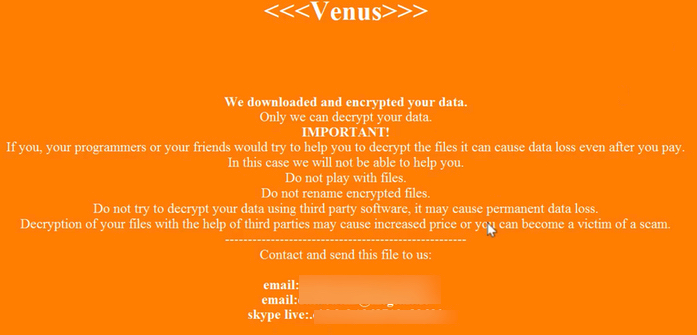
The Venus ransom group’s extortion note. Image: Tripwire.com
Holden said the CLOP ransomware gang has a different problem of late: Not enough victims. The intercepted CLOP communication seen by KrebsOnSecurity shows the group bragged about twice having success infiltrating new victims in the healthcare industry by sending them infected files disguised as ultrasound images or other medical documents for a patient seeking a remote consultation.
The CLOP members said one tried-and-true method of infecting healthcare providers involved gathering healthcare insurance and payment data to use in submitting requests for a remote consultation on a patient who has cirrhosis of the liver.
“Basically, they’re counting on doctors or nurses reviewing the patient’s chart and scans just before the appointment,” Holden said. “They initially discussed going in with cardiovascular issues, but decided cirrhosis or fibrosis of the liver would be more likely to be diagnosable remotely from existing test results and scans.”
While CLOP as a money making collective is a fairly young organization, security experts say CLOP members hail from a group of Threat Actors (TA) known as “TA505,” which MITRE’s ATT&CK database says is a financially motivated cybercrime group that has been active since at least 2014. “This group is known for frequently changing malware and driving global trends in criminal malware distribution,” MITRE assessed.
In April, 2021, KrebsOnSecurity detailed how CLOP helped pioneer another innovation aimed at pushing more victims into paying an extortion demand: Emailing the ransomware victim’s customers and partners directly and warning that their data would be leaked to the dark web unless they can convince the victim firm to pay up.
Security firm Tripwire points out that the HHS advisory on Venus says multiple threat actor groups are likely distributing the Venus ransomware. Tripwire’s tips for all organizations on avoiding ransomware attacks include:
While the above tips are important and useful, one critical area of ransomware preparedness overlooked by too many organizations is the need to develop — and then periodically rehearse — a plan for how everyone in the organization should respond in the event of a ransomware or data ransom incident. Drilling this breach response plan is key because it helps expose weaknesses in those plans that could be exploited by the intruders.
As noted in last year’s story Don’t Wanna Pay Ransom Gangs? Test Your Backups, experts say the biggest reason ransomware targets and/or their insurance providers still pay when they already have reliable backups of their systems and data is that nobody at the victim organization bothered to test in advance how long this data restoration process might take.
“Suddenly the victim notices they have a couple of petabytes of data to restore over the Internet, and they realize that even with their fast connections it’s going to take three months to download all these backup files,” said Fabian Wosar, chief technology officer at Emsisoft. “A lot of IT teams never actually make even a back-of-the-napkin calculation of how long it would take them to restore from a data rate perspective.”




As 2022 draws to a close, the Threat Research Team at McAfee Labs takes a look forward—offering their predictions for 2023 and how its threat landscape may take shape.
This year saw the continued evolution of scams, which is unlikely to slow down, as well as greater adoption of Chrome as an operating system. It also saw the introduction of AI tools that are easy and accessible to virtually anyone with a phone or laptop, which will continue to have significant implications, as will the fluctuating popularity of cryptocurrency and the emergence of “Web3.”
Advances such as these have set the stage for 2023, which will continue to reshape our interactions with technology—advances that bad actors will try to exploit, and in turn, us.
Yet as the threat landscape continues to evolve, so do the ways we can protect ourselves. With that, we share McAfee’s threat predictions for 2023, along with insights and advice that can help us enjoy the advances to come with confidence.
By Steve Grobman, Chief Technology Officer
Humans have been fascinated by artificial intelligence (AI) for almost as long as we’ve been using computers. And in some cases, even fearful of it. Depictions in pop culture range from HAL, the sentient computer from 2001: A Space Odyssey to Skynet, the self-aware neural network at the center of the Terminator franchise. The reality of current AI technologies is both more complicated and less autonomous than either of these. While AI is rapidly evolving, humans remain at the heart of it, and whether it’s put to beneficial or nefarious use.
Within the last few months, creating AI-generated images, videos, and even voices are no longer strictly left to professionals. Now anyone with a phone or computer can take advantage of the technology using publicly available applications like Open AI’s Dall-E or stability.ai’s Stable Diffusion. Google has even made creating AI-generated videos easier than ever.
What does this mean for the future? It means the next generation of content creation is becoming available to the masses and will only continue to evolve. People both at work and at home will have the ability to create the AI-generated content in minutes. Just as desktop publishing, photo editing, and inexpensive photorealistic home printers created major advances that empowered individuals to create content that previously required a professional designer, these technologies will enable sophisticated outputs with minimal expertise or effort.
Advances in desktop publishing and consumer printing also provided benefits to criminals, enabling better counterfeiting and more realistic manipulation of images. Similarly, these emerging next-generation content tools will also be used by a range of bad actors. From cybercriminals to those seeking to falsely influence public opinion, these tools will empower scammers and propagandists to take their tradecraft to the next level with more realistic results and significantly improved efficiency.
This is especially likely to ramp up in 2023 as the U.S. begins the 2024 presidential election cycle in earnest. Globally, the political environment is polarized. The confluence of the emergence of accessible next-generation generative AI tools and what is sure to be a highly contested 2024 election season is a perfect storm for creating and distributing disinformation for political and monetary gain.
We’ll all need to be more mindful of the content we consume and the sources that it originates from. Fact-checking images, videos, and news content, something that’s already on the rise, will continue to be a necessary and valuable part of media consumption.
By Oliver Devane, Security Researcher
Cryptocurrency scams
In 2022 we saw several online scams making use of existing content to make crypto scams more believable. One such example was the double your money cryptocurrency scam that used an old Elon Musk video as a lure. We expect such scams to evolve in 2023 and make use of deep fake videos, as well as audio, to trick victims into parting ways with their hard-earned money.

The financial outlook of 2023 remains uncertain for many people. During these times, people often look for ways to make some extra money and this can lead them vulnerable to social media messages and online ads that offer huge financial gains for little investment.
According to the IC3 2021 report, the losses for financial scams increased from $336,469,000 in 2020 to $1,455,943,193 in 2021, this shows that this type of scam is growing by an enormous amount, and we expect this to continue.
Unfortunately, scammers will often target the most vulnerable people. Fake loan scams are one such scam where the scammers know that the victims are desperate for the loan and therefore are less likely to react to warning signs such as asking for an upfront fee. McAfee predicts that there will be a large increase in these types of scams in 2023. When looking for a loan, always use a trusted provider and be careful of clicking on online ads.
Metaverses such as Facebook’s Horizon enable their users to explore an online world that was previously unimaginable. When these platforms are in the early stages, malicious actors will usually attempt to exploit the lack of understanding of how they work and use this to scam people. We have observed phishing campaigns targeting users of these platforms in 2022 and we expect this to increase dramatically in 2023 as more and more users sign up for the platforms.
By Craig Schmugar, McAfee Senior Principal Engineer
More than 25 years ago, Windows 95 became the platform of choice not just for millions of users around the globe, but for malware authors targeting those users. Over the years, Windows has evolved, as has the threat landscape. Today, Windows 10 and 11 make up the majority of the desktop PC market, but thanks to the rise of the mobile Internet, device diversity has greatly evolved since the advent of Windows 95.
Over five years ago, Android overtook Windows as the world’s most popular OS and with this shift bad actors have been pursing alternative methods of attack. The ultimate vectors are those which impact users across a spectrum of devices. Email and web-based scams (some of which are outlined in the blog above) are as prolific as ever as these technologies are ubiquitous across desktop and mobile devices.
Meanwhile, other technologies span across desktop and mobile experiences as well. For Google, such cross-platform capabilities are highlighted by increased adoption of ChromeOS and a few underlying technologies. This includes 270 million active Android users and a 270% increase in Progressive Web Application (PWA) installations [https://chromeos.dev]. ChromeOS’ ability to run Android applications, combined with its wide-spread adoption, provides the climate for increased attention by those with ill intentions.
Similarly, adoption of PWAs provide bad actors with additional incentive to deliver deceptive and imposter attacks through this multi-OS channel, including ChromeOS, iOS, MacOS, and Windows.
Finally, on the heels of COVID restrictions that impacted schools in various countries, Google reported 50 million students and educators worldwide [https://chromeos.dev] using ChromeOS. Many users will be unaware of malicious Chrome extensions lurking in the Chrome Web Store.
All of this means that the stage is set for a marked increase in threats impacting Chromebook in the year to come. In 2023, we can expect to see Chromebook users among millions of unsuspecting victims that download and run malicious content, whether from malicious Android Apps, Progressive Web Apps, or Chrome Web Store extensions, users should be leery of popups and push notifications urging them to install untrusted apps.
By Fernando Ruiz, Senior Security Researcher
Editor’s Note: Web3? FOMO? If you’re already lost, you’re not alone. Web3 is a term some use to encompass decentralized internet services, technologies like Bitcoin and Non-Fungible Tokens (digital art that collectors can purchase with cryptocurrency). Still confused? A lot of people are. This New York Times article is a good primer on what is currently considered Web3.
As for FOMO, that’s just an acronym meaning the “Fear of Missing Out.” That nagging feeling, most often felt by extroverts, that others are out there having more fun than them and that they’re missing the party.
Whether you invest in cryptocurrency or just see the headlines on Twitter, no doubt you’ve seen that the price of cryptocurrency has sharply declined during 2022. These fluctuations are becoming more normal as crypto becomes even more mainstream. It’s very likely that the value of crypto will rise again.
When the last upturn in valuation happened near the start of the pandemic, the hype about crypto also skyrocketed. Suddenly Bitcoin and other cryptocurrencies were everywhere. Out of that, rose the concept of Web3, with more companies investing in new applications over blockchain (the technology that is the backbone of cryptocurrency).
McAfee predicts that the popularity of cryptocurrency will rise again, and consumers will hear much more about Web3 concepts like decentralized finance (DeFi), decentralized autonomous organizations (DAOs), self-sovereign identity (SSI) and more.
Some amateur investors, remembering the rapid rise of the value of Bitcoin earlier this decade, won’t want to miss out on what they think will be a great opportunity to get rich quick. It’s this group that bad actors will seek to exploit, offering up links or applications that play on these users’ crypto/Web3 FOMO.
As crypto bounces back and initial awareness of decentralization grows in the general population, consumers will begin to explore these Web3 offerings without fully understanding what they mean or what dangers they should be aware of, leaving them open to scams as they invest time and money into crypto or creating their own NFT content. These scams could entice users to click on a link or download an app that appears to legitimately interact with some blockchains, but in actuality:
Additionally, when consumers DO hold crypto, NFT, digital land, or other blockchain financial assets they are going to be targeted for more sophisticated threats that can drain their funds: smart contracts, exchanges, digital wallets, and synchronization services can all be associated with hidden authorizations that allow a third party (potentially a bad actor) to take control of the assets. It’s important that users read the terms and conditions of any app they download, especially those that will be accessing ANY type of financial institution or currency, whether traditional or crypto.
Social engineering will also continue to be a top entry point for cybercriminals. The complexity of the attacks will evolve as the technology does, which will require more preparation and understanding of how Web3 applications and tools work in order to safely interact with them.
What has emerged from the world of Web3 thus far, while exciting, has also expanded attack surfaces and vectors, which we expect to see grow throughout 2023 as Web3 evolves.
The post McAfee 2023 Threat Predictions: Evolution and Exploitation appeared first on McAfee Blog.



In December 2021, Google filed a civil lawsuit against two Russian men thought to be responsible for operating Glupteba, one of the Internet’s largest and oldest botnets. The defendants, who initially pursued a strategy of counter suing Google for interfering in their sprawling cybercrime business, later brazenly offered to dismantle the botnet in exchange for payment from Google. The judge in the case was not amused, found for the plaintiff, and ordered the defendants and their U.S. attorney to pay Google’s legal fees.
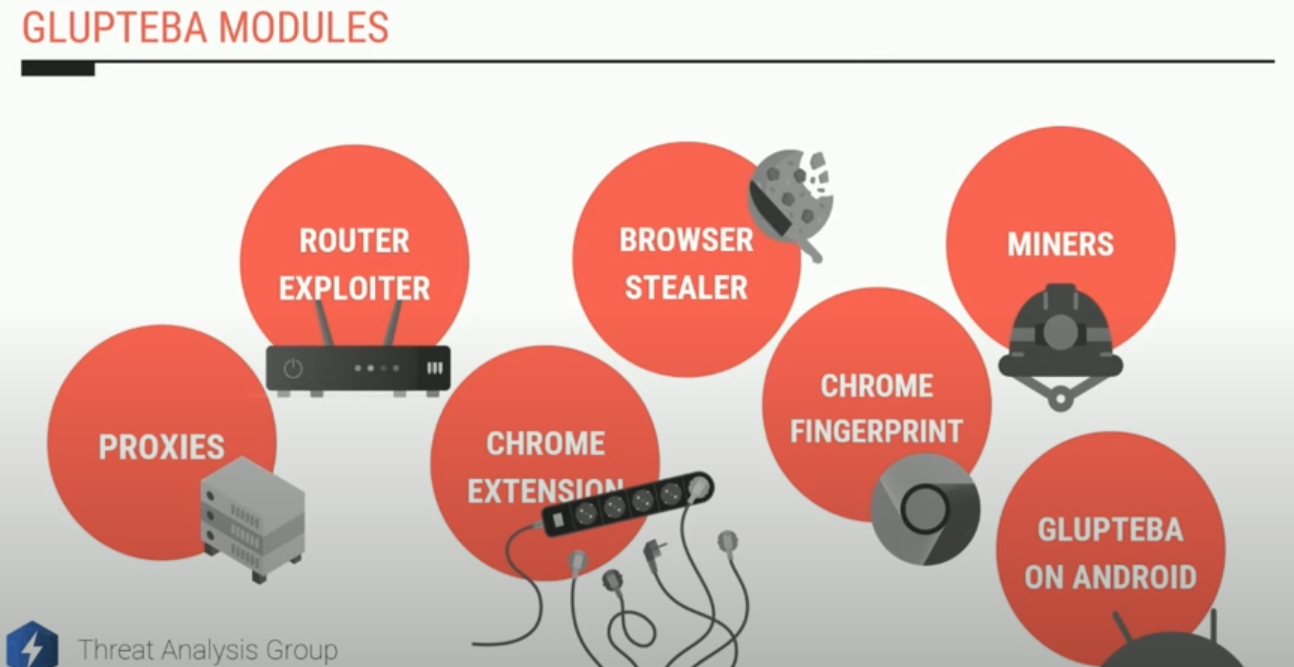
A slide from a talk given in Sept. 2022 by Google researcher Luca Nagy. https://www.youtube.com/watch?v=5Gz6_I-wl0E&t=6s
Glupteba is a rootkit that steals passwords and other access credentials, disables security software, and tries to compromise other devices on the victim network — such as Internet routers and media storage servers — for use in relaying spam or other malicious traffic.
Collectively, the tens of thousands of systems infected with Glupteba on any given day feed into a number of major cybercriminal businesses: The botnet’s proprietors sell the credential data they steal, use the botnet to place disruptive ads on the infected computers, and mine cryptocurrencies. Glupteba also rents out infected systems as “proxies,” directing third-party traffic through the infected devices to disguise the origin of the traffic.
In June 2022, KrebsOnSecurity showed how the malware proxy services RSOCKS and AWMProxy were entirely dependent on the Glupteba botnet for fresh proxies, and that the founder of AWMProxy was Dmitry Starovikov — one of the Russian men named in Google’s lawsuit.
Google sued Starovikov and 15 other “John Doe” defendants, alleging violations of the Racketeer Influenced and Corrupt Organizations Act (RICO), the Computer Fraud and Abuse Act, trademark and unfair competition law, and unjust enrichment.
In June, Google and the named defendants agreed that the case would proceed as a nonjury action because Google had withdrawn its claim for damages — seeking only injunctive relief to halt the operations of the botnet.
The defendants, who worked for a Russian firm called “Valtron” that was also named in the lawsuit, told Google that they were interested in settling. The defendants said they could potentially help Google by taking the botnet offline.
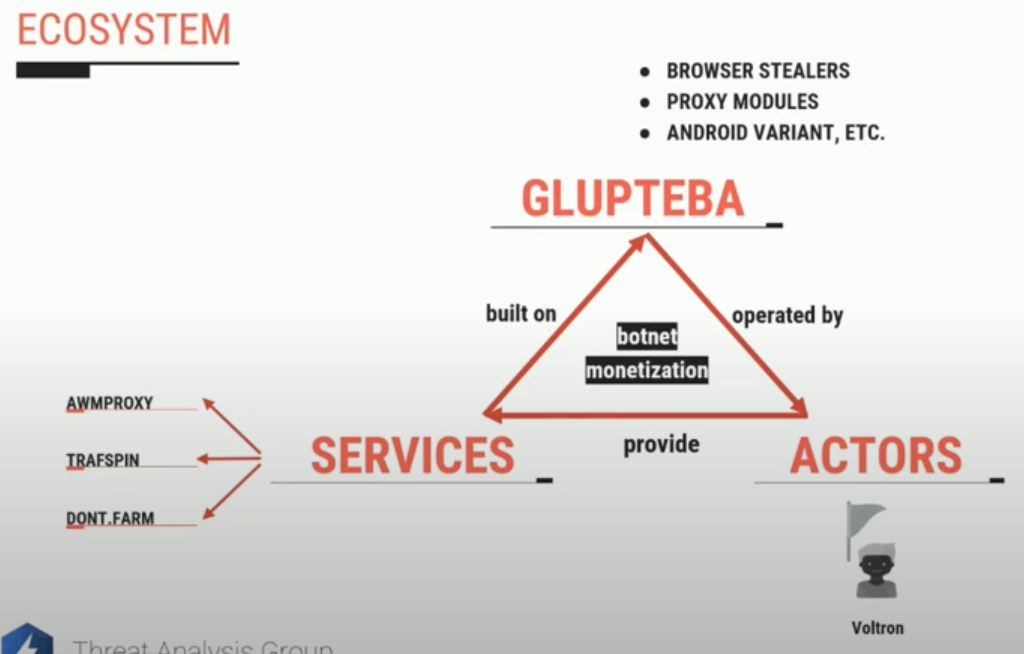
Another slide from Google researcher Luca Nagy’s September 2022 talk on Glupteba.
But the court expressed frustration that the defendants were unwilling to consent to a permanent injunction, and at the same time were unable to articulate why an injunction forbidding them from engaging in unlawful activities would pose a problem.
“The Defendants insisted that they were not engaged in criminal activity, and that any alleged activity in which they were engaged was legitimate,” U.S. District Court Judge Denise Cote wrote. “Nevertheless, the Defendants resisted entry of a permanent injunction, asserting that Google’s use of the preliminary injunction had disrupted their normal business operations.”
While the defendants represented that they had the ability to dismantle the Glupteba botnet, when it came time for discovery — the stage in a lawsuit where both parties can compel the production of documents and other information pertinent to their case — the attorney for the defendants told the court his clients had been fired by Valtron in late 2021, and thus no longer had access to their work laptops or the botnet.
The lawyer for the defendants — New York-based cybercrime defense attorney Igor Litvak — told the court he first learned about his clients’ termination from Valtron on May 20, a fact Judge Cote said she found “troubling” given statements he made to the court after that date representing that his clients still had access to the botnet.
The court ultimately suspended the discovery process against Google, saying there was reason to believe the defendants sought discovery only “to learn whether they could circumvent the steps Google has taken to block the malware.”
On September 6, Litvak emailed Google that his clients were willing to discuss settlement.
“The parties held a call on September 8, at which Litvak explained that the Defendants would be willing to provide Google with the private keys for Bitcoin addresses associated with the Glupteba botnet, and that they would promise not to engage in their alleged criminal activity in the future (without any admission of wrongdoing),” the judge wrote.
“In exchange, the Defendants would receive Google’s agreement not to report them to law enforcement, and a payment of $1 million per defendant, plus $110,000 in attorney’s fees,” Judge Cote continued. “The Defendants stated that, although they do not currently have access to the private keys, Valtron would be willing to provide them with the private keys if the case were settled. The Defendants also stated that they believe these keys would help Google shut down the Glupteba botnet.”
Google rejected the defendants’ offer as extortionate, and reported it to law enforcement. Judge Cote also found Litvak was complicit in the defendants’ efforts to mislead the court, and ordered him to join his clients in paying Google’s legal fees.
“It is now clear that the Defendants appeared in this Court not to proceed in good faith to defend against Google’s claims but with the intent to abuse the court system and discovery rules to reap a profit from Google,” Judge Cote wrote.
Litvak has filed a motion to reconsider (PDF), asking the court to vacate the sanctions against him. He said his goal is to get the case back into court.
“The judge was completely wrong to issue sanctions,” Litvak said in an interview with KrebsOnSecurity. “From the beginning of the case, she acted as if she needed to protect Google from something. If the court does not decide to vacate the sanctions, we will have to go to the Second Circuit (Court of Appeals) and get justice there.”
In a statement on the court’s decision, Google said it will have significant ramifications for online crime, and that since its technical and legal attacks on the botnet last year, Google has observed a 78 percent reduction in the number of hosts infected by Glupteba.
“While Glupteba operators have resumed activity on some non-Google platforms and IoT devices, shining a legal spotlight on the group makes it less appealing for other criminal operations to work with them,” reads a blog post from Google’s General Counsel Halimah DeLaine Prado and vice president of engineering Royal Hansen. “And the steps [Google] took last year to disrupt their operations have already had significant impact.”
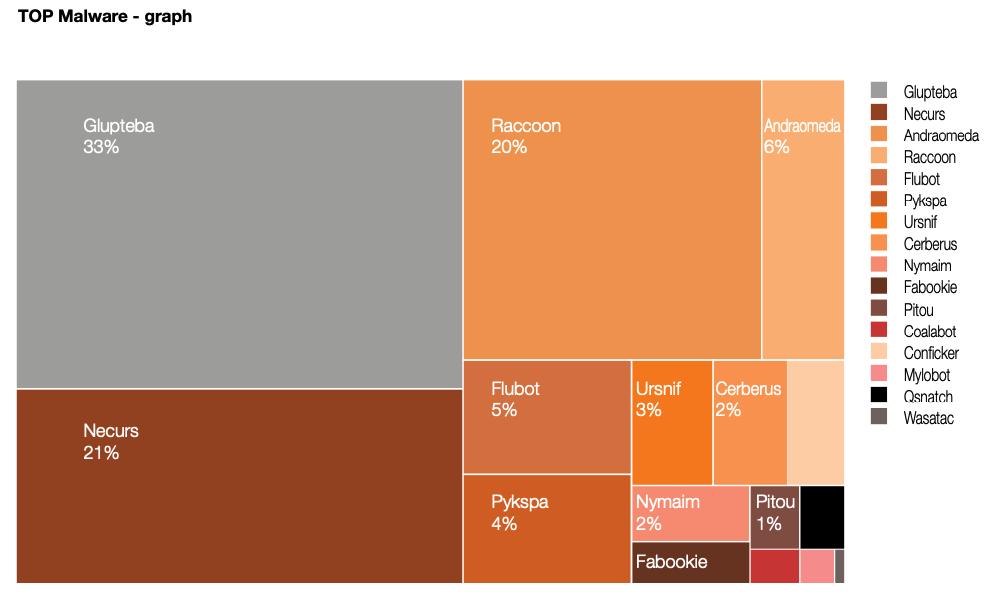
A report from the Polish computer emergency response team (CERT Orange Polksa) found Glupteba was the biggest malware threat in 2021.
For these Cisconians, hands-on is the way to go when it comes to giving back. Using Cisco’s Time2Give benefit that provides 10 paid days to volunteer each year, team members rolled up their sleeves to build homes, cuddle and care for animals, distribute food and more. If you also value giving back, check out our open roles.
Marketing Specialist, Global Events Julie Kramer used Time2Give to build a shed with Habitat for Humanity of Huron Valley. Kramer especially appreciated learning about the organization’s purpose in addition to learning how to build.

John Hindman, an account executive, used Time2Give to spend a week in Nicaragua with SuNica, an organization centered on clean water and fellowship. Hindman cleared out downed trees, picked coffee and built treehouses to allow the organization to host more children from surrounding communities.

In the community Hindman visited, repurposing recycled materials is critical to the economy, and one way that happens is through “mining” the local landfill. Hindman’s team encouraged local employees and led games and activities for local children.

For those considering Time2Give, Hindman says, “Do it. Unplug, find something you’re passionate about, set up your out-of-office, and ignore everything work-related for the time you’re serving.”

Animal lover Carrie Cordeiro, a Cisco Secure digital strategist/manager on the Brand Marketing team, volunteers with Hopalong and Muttville as a kitten cuddler and dog walker. Most of her time is spent transporting kittens, puppies, cats and dogs around the Bay Area to vet appointments, adoption centers and foster locations.
The best part for Cordeiro is “getting to interact with so many adorable animals,” she said. As for leadership support around utilizing Time2Give? “I love doing it and my management team absolutely supports it, especially when I share photos.”

Customer Success Manager Kristen Gehrke reminds us that, “You don’t always have to look far to utilize Time2Give.” She sewed a baby blanket for Bluebonnet Trails Community Services. “The best part of the experience was giving back to mothers and their babies, as I am an expecting mother myself,” she said.
Engineering Manager Blake Ellingham organized food pantry shelves and packed bags for food distributions with HTB Food Bank. “I love getting to do work with my hands that helps others,” he said.

Ellingham recommends scheduling something routine for Time2Give. “Consistency matters! By going in every week for a half day of volunteering, I was able to make great friends with the staff,” he said.
From empowering youth globally and remotely to volunteering across community hubs, Cisconians deeply value innovative ways to contribute their time and talents.
If you are interested in increasing the impact of your skills and passions at work and beyond, check out our open positions.
We’d love to hear what you think. Ask a Question, Comment Below, and Stay Connected with Cisco Secure on social!
Cisco Secure Social Channels


xmas-1200-35-wide




After a three-year hiatus, Cisco Live 2022 Melbourne is back! Personally, it will be a special experience, attending with my team and leaders for the first time as the Asia Pacific Cybersecurity Lead.
I will be speaking on the “Top Priorities for IT and Security Leaders in 2023” on 7 December at the Cisco Secure Insights Live, covering key priorities for security leaders as we enter the new year. Please join me at the Security Experience Hub at the World of Solutions. You can also participate virtually.
Today’s businesses require a strong culture of security and resilience that is pervasive throughout the organization to withstand uncertainty and emerge stronger. Hear from our Cisco security leaders on powering resilience across the enterprise in the following presentations:
Dive into 80+ security sessions by experts to uncover best practices to address key challenges, and maximize your technology investments.
Explore the Security Experience Hub and Demo Stand at the World of Solutions Zone for exciting security activities:
For those joining us online, we have the Cisco Secure Insights Live broadcast on all things security, and Cisco Live broadcast covering keynote presentations by industry leaders.
I’m excited for you to see how we can help you achieve security resilience and look forward to meeting you at Cisco Live 2022 Melbourne. I’m ALL IN, are you?
We’d love to hear what you think. Ask a Question, Comment Below, and Stay Connected with Cisco Secure on social!
Cisco Secure Social Channels
A recent scoop by Reuters revealed that mobile apps for the U.S. Army and the Centers for Disease Control and Prevention (CDC) were integrating software that sends visitor data to a Russian company called Pushwoosh, which claims to be based in the United States. But that story omitted an important historical detail about Pushwoosh: In 2013, one of its developers admitted to authoring the Pincer Trojan, malware designed to surreptitiously intercept and forward text messages from Android mobile devices.
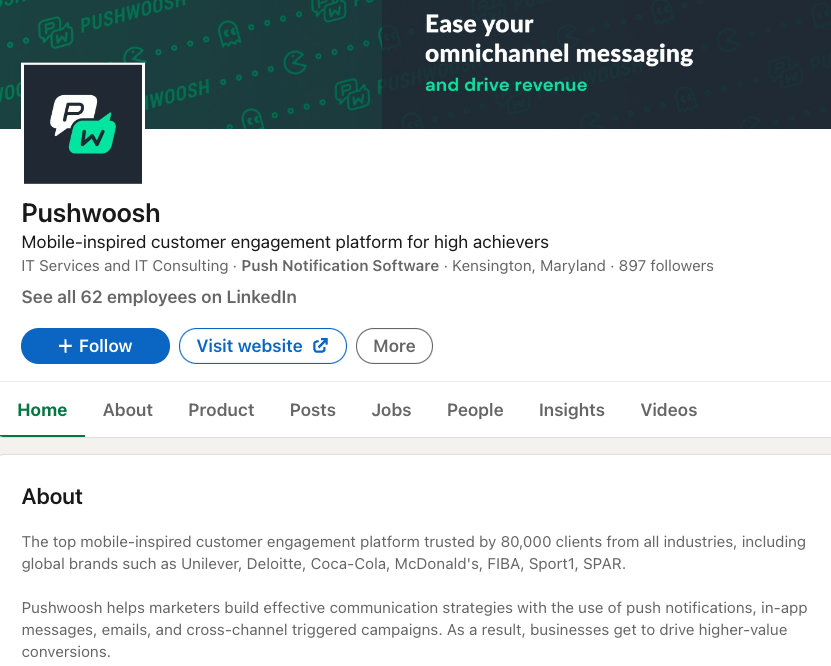
Pushwoosh says it is a U.S. based company that provides code for software developers to profile smartphone app users based on their online activity, allowing them to send tailor-made notifications. But a recent investigation by Reuters raised questions about the company’s real location and truthfulness.
The Army told Reuters it removed an app containing Pushwoosh in March, citing “security concerns.” The Army app was used by soldiers at one of the nation’s main combat training bases.
Reuters said the CDC likewise recently removed Pushwoosh code from its app over security concerns, after reporters informed the agency Pushwoosh was not based in the Washington D.C. area — as the company had represented — but was instead operated from Novosibirsk, Russia.
Pushwoosh’s software also was found in apps for “a wide array of international companies, influential nonprofits and government agencies from global consumer goods company Unilever and the Union of European Football Associations (UEFA) to the politically powerful U.S. gun lobby, the National Rifle Association (NRA), and Britain’s Labour Party.”
The company’s founder Max Konev told Reuters Pushwoosh “has no connection with the Russian government of any kind” and that it stores its data in the United States and Germany.
But Reuters found that while Pushwoosh’s social media and U.S. regulatory filings present it as a U.S. company based variously in California, Maryland and Washington, D.C., the company’s employees are located in Novosibirsk, Russia.
Reuters also learned that the company’s address in California does not exist, and that two LinkedIn accounts for Pushwoosh employees in Washington, D.C. were fake.
“Pushwoosh never mentioned it was Russian-based in eight annual filings in the U.S. state of Delaware, where it is registered, an omission which could violate state law,” Reuters reported.
Pushwoosh admitted the LinkedIn profiles were fake, but said they were created by a marketing firm to drum up business for the company — not misrepresent its location.
Pushwoosh told Reuters it used addresses in the Washington, D.C. area to “receive business correspondence” during the coronavirus pandemic. A review of the Pushwoosh founder’s online presence via Constella Intelligence shows his Pushwoosh email address was tied to a phone number in Washington, D.C. that was also connected to email addresses and account profiles for over a dozen other Pushwoosh employees.
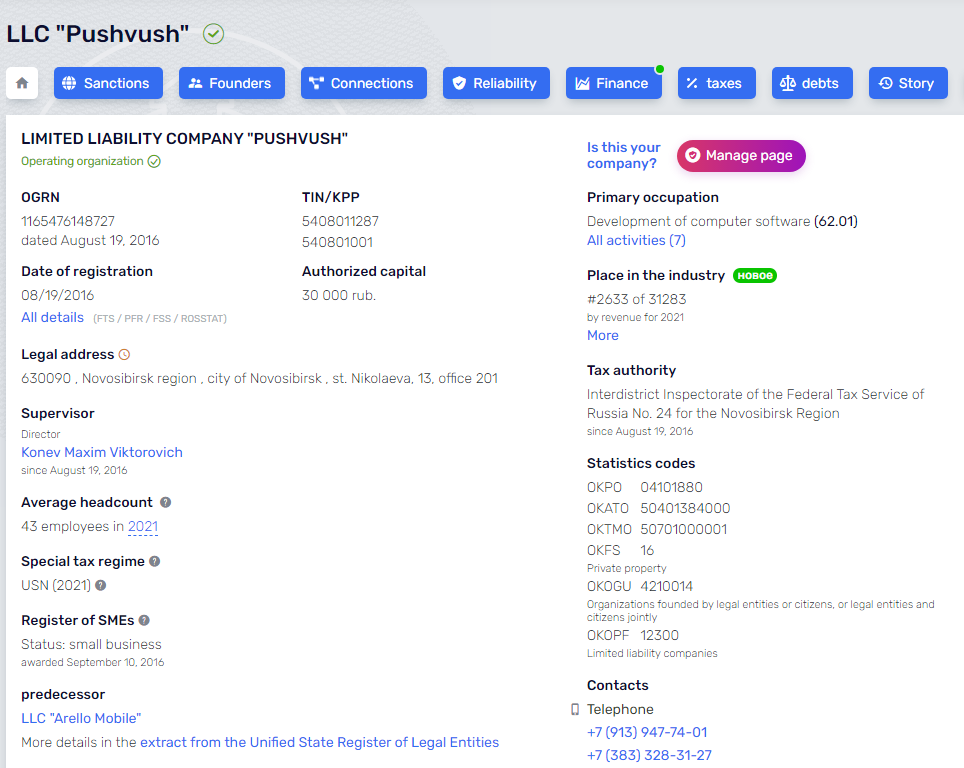
Pushwoosh was incorporated in Novosibirsk, Russia in 2016.
The dust-up over Pushwoosh came in part from data gathered by Zach Edwards, a security researcher who until recently worked for the Internet Safety Labs, a nonprofit organization that funds research into online threats.
Edwards said Pushwoosh began as Arello-Mobile, and for several years the two co-branded — appearing side by side at various technology expos. Around 2016, he said, the two companies both started using the Pushwoosh name.
A search on Pushwoosh’s code base shows that one of the company’s longtime developers is a 41-year-old from Novosibirsk named Yuri Shmakov. In 2013, KrebsOnSecurity interviewed Shmakov for the story, “Who Wrote the Pincer Android Trojan?” wherein Shmakov acknowledged writing the malware as a freelance project.
Shmakov told me that, based on the client’s specifications, he suspected it might ultimately be put to nefarious uses. Even so, he completed the job and signed his work by including his nickname in the app’s code.
“I was working on this app for some months, and I was hoping that it would be really helpful,” Shmakov wrote. “[The] idea of this app is that you can set it up as a spam filter…block some calls and SMS remotely, from a Web service. I hoped that this will be [some kind of] blacklist, with logging about blocked [messages/calls]. But of course, I understood that client [did] not really want this.”
Shmakov did not respond to requests for comment. His LinkedIn profile says he stopped working for Arello Mobile in 2016, and that he currently is employed full-time as the Android team leader at an online betting company.
In a blog post responding to the Reuters story, Pushwoosh said it is a privately held company incorporated under the state laws of Delaware, USA, and that Pushwoosh Inc. was never owned by any company registered in the Russian Federation.
“Pushwoosh Inc. used to outsource development parts of the product to the Russian company in Novosibirsk, mentioned in the article,” the company said. “However, in February 2022, Pushwoosh Inc. terminated the contract.”
However, Edwards noted that dozens of developer subdomains on Pushwoosh’s main domain still point to JSC Avantel, an Internet provider based in Novosibirsk, Russia.
Edwards said the U.S. Army’s app had a custom Pushwoosh configuration that did not appear on any other customer implementation.
“It had an extremely custom setup that existed nowhere else,” Edwards said. “Originally, it was an in-app Web browser, where it integrated a Pushwoosh javascript so that any time a user clicked on links, data went out to Pushwoosh and they could push back whatever they wanted through the in-app browser.”
An Army Times article published the day after the Reuters story ran said at least 1,000 people downloaded the app, which “delivered updates for troops at the National Training Center on Fort Irwin, Calif., a critical waypoint for deploying units to test their battlefield prowess before heading overseas.”
In April 2022, roughly 4,500 Army personnel converged on the National Training Center for a war games exercise on how to use lessons learned from Russia’s war against Ukraine to prepare for future fights against a major adversary such as Russia or China.
Edwards said despite Pushwoosh’s many prevarications, the company’s software doesn’t appear to have done anything untoward to its customers or users.
“Nothing they did has been seen to be malicious,” he said. “Other than completely lying about where they are, where their data is being hosted, and where they have infrastructure.”
Edwards also found Pushwoosh’s technology embedded in nearly two dozen mobile apps that were sold to cities and towns across Illinois as a way to help citizens access general information about their local communities and officials.
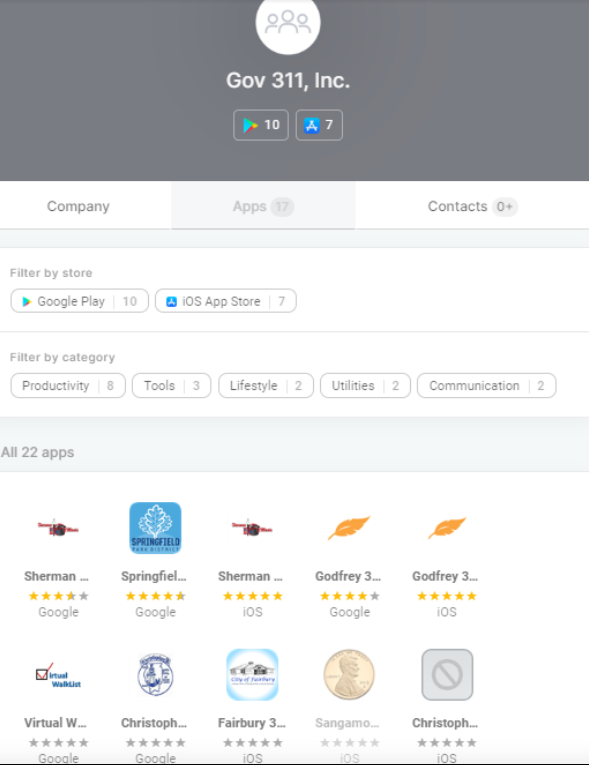 The Illinois apps that bundled Pushwoosh’s technology were produced by a company called Government 311, which is owned by Bill McCarty, the current director of the Springfield Office of Budget and Management. A 2014 story in The State Journal-Register said Gov 311’s pricing was based on population, and that the app would cost around $2,500 per year for a city with approximately 25,000 people.
The Illinois apps that bundled Pushwoosh’s technology were produced by a company called Government 311, which is owned by Bill McCarty, the current director of the Springfield Office of Budget and Management. A 2014 story in The State Journal-Register said Gov 311’s pricing was based on population, and that the app would cost around $2,500 per year for a city with approximately 25,000 people.
McCarty told KrebsOnSecurity that his company stopped using Pushwoosh “years ago,” and that it now relies on its own technology to provide push notifications through its 311 apps.
But Edwards found some of the 311 apps still try to phone home to Pushwoosh, such as the 311 app for Riverton, Ill.
“Riverton ceased being a client several years ago, which [is] probably why their app was never updated to change out Pushwoosh,” McCarty explained. “We are in the process of updating all client apps and a website refresh. As part of that, old unused apps like Riverton 311 will be deleted.”
Edwards said it’s far from clear how many other state and local government apps and Web sites rely on technology that sends user data to U.S. adversaries overseas. In July, Congress introduced an amended version of the Intelligence Authorization Act for 2023, which included a new section focusing on data drawn from online ad auctions that could be used to geolocate individuals or gain other information about them.
Business Insider reports that if this section makes it into the final version — which the Senate also has to pass — the Office for the Director of National Intelligence (ODNI) will have 60 days after the Act becomes law to produce a risk assessment. The assessment will look into “the counterintelligence risks of, and the exposure of intelligence community personnel to, tracking by foreign adversaries through advertising technology data,” the Act states.
Edwards says he’s hoping those changes pass, because what he found with Pushwoosh is likely just a drop in a bucket.
“I’m hoping that Congress acts on that,” he said. “If they were to put a requirement that there’s an annual audit of risks from foreign ad tech, that would at least force people to identify and document those connections.”




Peter is an IT manager for a technology manufacturer that got hit with a Russian ransomware strain called “Zeppelin” in May 2020. He’d been on the job less than six months, and because of the way his predecessor architected things, the company’s data backups also were encrypted by Zeppelin. After two weeks of stalling their extortionists, Peter’s bosses were ready to capitulate and pay the ransom demand. Then came the unlikely call from an FBI agent. “Don’t pay,” the agent said. “We’ve found someone who can crack the encryption.”
Peter, who spoke candidly about the attack on condition of anonymity, said the FBI told him to contact a cybersecurity consulting firm in New Jersey called Unit 221B, and specifically its founder — Lance James. Zeppelin sprang onto the crimeware scene in December 2019, but it wasn’t long before James discovered multiple vulnerabilities in the malware’s encryption routines that allowed him to brute-force the decryption keys in a matter of hours, using nearly 100 cloud computer servers.
In an interview with KrebsOnSecurity, James said Unit 221B was wary of advertising its ability to crack Zeppelin ransomware keys because it didn’t want to tip its hand to Zeppelin’s creators, who were likely to modify their file encryption approach if they detected it was somehow being bypassed.
This is not an idle concern. There are multiple examples of ransomware groups doing just that after security researchers crowed about finding vulnerabilities in their ransomware code.
“The minute you announce you’ve got a decryptor for some ransomware, they change up the code,” James said.
But he said the Zeppelin group appears to have stopped spreading their ransomware code gradually over the past year, possibly because Unit 221B’s referrals from the FBI let them quietly help nearly two dozen victim organizations recover without paying their extortionists.
In a blog post published today to coincide with a Black Hat talk on their discoveries, James and co-author Joel Lathrop said they were motivated to crack Zeppelin after the ransomware gang started attacking nonprofit and charity organizations.
“What motivated us the most during the leadup to our action was the targeting of homeless shelters, nonprofits and charity organizations,” the two wrote. “These senseless acts of targeting those who are unable to respond are the motivation for this research, analysis, tools, and blog post. A general Unit 221B rule of thumb around our offices is: Don’t [REDACTED] with the homeless or sick! It will simply trigger our ADHD and we will get into that hyper-focus mode that is good if you’re a good guy, but not so great if you are an ***hole.”
The researchers said their break came when they understood that while Zeppelin used three different types of encryption keys to encrypt files, they could undo the whole scheme by factoring or computing just one of them: An ephemeral RSA-512 public key that is randomly generated on each machine it infects.
“If we can recover the RSA-512 Public Key from the registry, we can crack it and get the 256-bit AES Key that encrypts the files!” they wrote. “The challenge was that they delete the [public key] once the files are fully encrypted. Memory analysis gave us about a 5-minute window after files were encrypted to retrieve this public key.”
Unit 221B ultimately built a “Live CD” version of Linux that victims could run on infected systems to extract that RSA-512 key. From there, they would load the keys into a cluster of 800 CPUs donated by hosting giant Digital Ocean that would then start cracking them. The company also used that same donated infrastructure to help victims decrypt their data using the recovered keys.
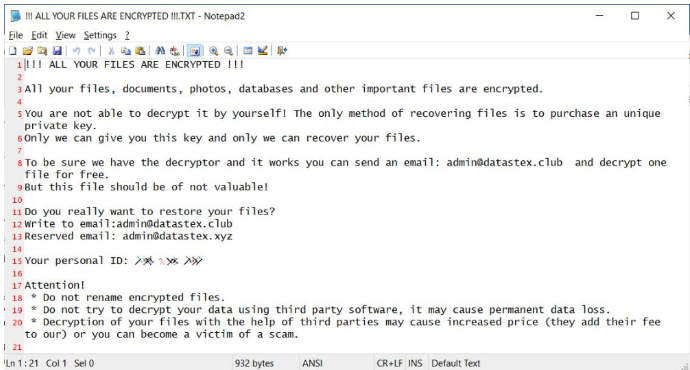
A typical Zeppelin ransomware note.
Jon is another grateful Zeppelin ransomware victim who was aided by Unit 221B’s decryption efforts. Like Peter, Jon asked that his last name and that of his employer be omitted from the story, but he’s in charge of IT for a mid-sized managed service provider that got hit with Zeppelin in July 2020.
The attackers that savaged Jon’s company managed to phish credentials and a multi-factor authentication token for some tools the company used to support customers, and in short order they’d seized control over the servers and backups for a healthcare provider customer.
Jon said his company was reluctant to pay a ransom in part because it wasn’t clear from the hackers’ demands whether the ransom amount they demanded would provide a key to unlock all systems, and that it would do so safely.
“They want you to unlock your data with their software, but you can’t trust that,” Jon said. “You want to use your own software or someone else who’s trusted to do it.”
In August 2022, the FBI and the Cybersecurity & Infrastructure Security Agency (CISA) issued a joint warning on Zeppelin, saying the FBI had “observed instances where Zeppelin actors executed their malware multiple times within a victim’s network, resulting in the creation of different IDs or file extensions, for each instance of an attack; this results in the victim needing several unique decryption keys.”
The advisory says Zeppelin has attacked “a range of businesses and critical infrastructure organizations, including defense contractors, educational institutions, manufacturers, technology companies, and especially organizations in the healthcare and medical industries. Zeppelin actors have been known to request ransom payments in Bitcoin, with initial amounts ranging from several thousand dollars to over a million dollars.”
The FBI and CISA say the Zeppelin actors gain access to victim networks by exploiting weak Remote Desktop Protocol (RDP) credentials, exploiting SonicWall firewall vulnerabilities, and phishing campaigns. Prior to deploying Zeppelin ransomware, actors spend one to two weeks mapping or enumerating the victim network to identify data enclaves, including cloud storage and network backups, the alert notes.
Jon said he felt so lucky after connecting with James and hearing about their decryption work, that he toyed with the idea of buying a lottery ticket that day.
“This just doesn’t usually happen,” Jon said. “It’s 100 percent like winning the lottery.”
By the time Jon’s company got around to decrypting their data, they were forced by regulators to prove that no patient data had been exfiltrated from their systems. All told, it took his employer two months to fully recover from the attack.
“I definitely feel like I was ill-prepared for this attack,” Jon said. “One of the things I’ve learned from this is the importance of forming your core team and having those people who know what their roles and responsibilities are ahead of time. Also, trying to vet new vendors you’ve never met before and build trust relationships with them is very difficult to do when you have customers down hard now and they’re waiting on you to help them get back up.”
A more technical writeup on Unit 221B’s discoveries (cheekily titled “0XDEAD ZEPPELIN”) is available here.
A financial cybercrime group calling itself the Disneyland Team has been making liberal use of visually confusing phishing domains that spoof popular bank brands using Punycode, an Internet standard that allows web browsers to render domain names with non-Latin alphabets like Cyrillic.
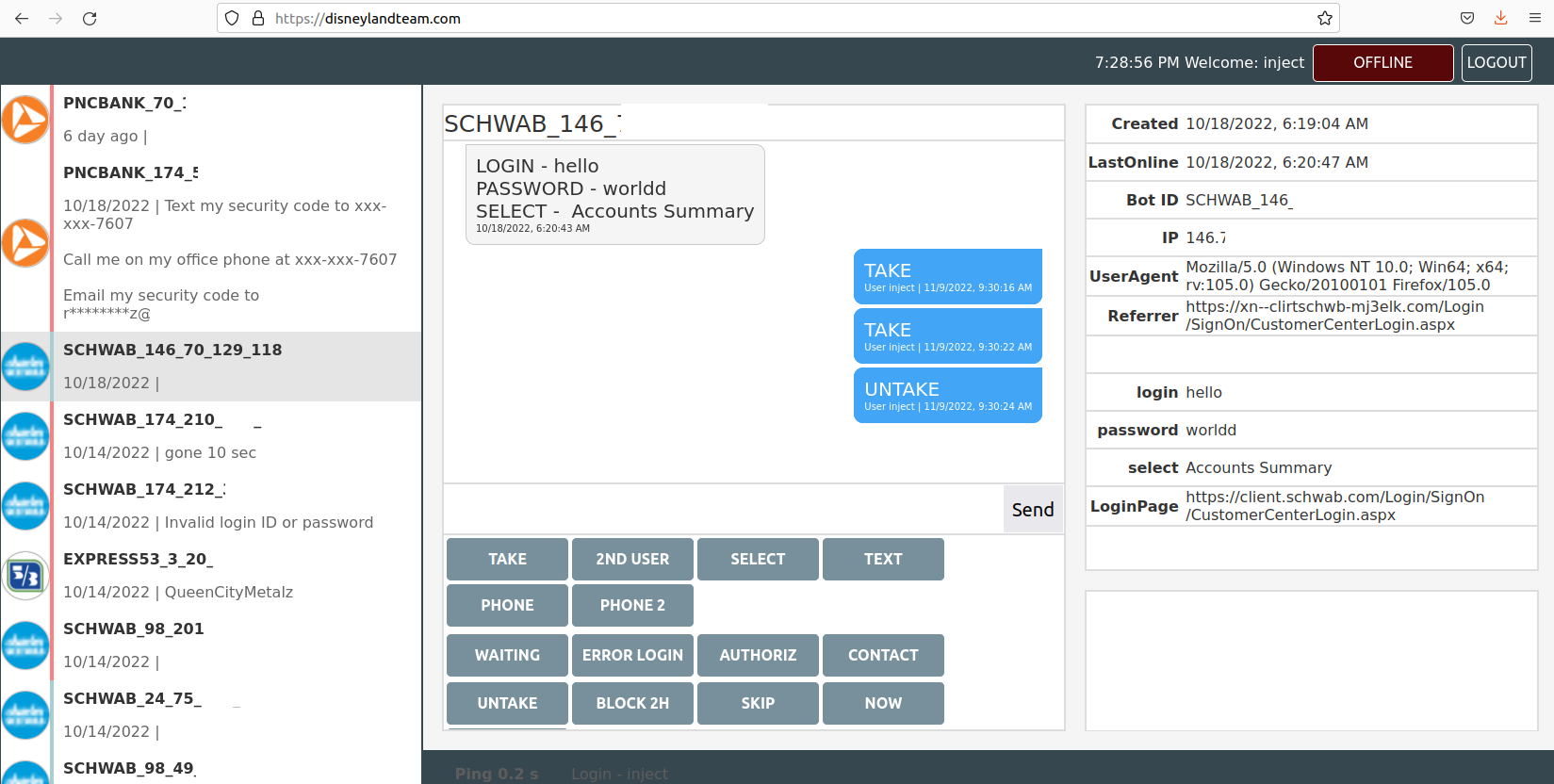
The Disneyland Team’s Web interface, which allows them to interact with malware victims in real time to phish their login credentials using phony bank websites.
The Disneyland Team uses common misspellings for top bank brands in its domains. For example, one domain the gang has used since March 2022 is ushank[.]com — which was created to phish U.S. Bank customers.
But this group also usually makes use of Punycode to make their phony bank domains look more legit. The U.S. financial services firm Ameriprise uses the domain ameriprise.com; the Disneyland Team’s domain for Ameriprise customers is https://www.xn--meripris-mx0doj[.]com [brackets added to defang the domain], which displays in the browser URL bar as ạmeriprisẹ[.]com.
Look carefully, and you’ll notice small dots beneath the “a” and the second “e”. You could be forgiven if you mistook one or both of those dots for a spec of dust on your computer screen or mobile device.
This candid view inside the Disneyland Team comes from Alex Holden, founder of the Milwaukee-based cybersecurity consulting firm Hold Security. Holden’s analysts gained access to a Web-based control panel the crime group has been using to keep track of victim credentials (see screenshot above). The panel reveals the gang has been operating dozens of Punycode-based phishing domains for the better part of 2022.
Have a look at the Punycode in this Disneyland Team phishing domain: https://login2.xn--mirtesnbd-276drj[.]com, which shows up in the browser URL bar as login2.ẹmirạtesnbd[.]com, a domain targeting users of Emirates NBD Bank in Dubai.
Here’s another domain registered this year by the Disneyland Team: https://xn--clientchwb-zxd5678f[.]com, which spoofs the login page of financial advisor Charles Schwab with the landing page of cliẹntșchwab[.]com. Again, notice the dots under the letters “e” and “s”. Another Punycode domain of theirs sends would-be victims to cliẹrtschwạb[.]com, which combines a brand misspelling with Punycode.
We see the same dynamic with the Disneyland Team Punycode domain https://singlepoint.xn--bamk-pxb5435b[.]com, which translates to singlepoint.ụșbamk[.]com — again phishing U.S. Bank customers.
What’s going on here? Holden says the Disneyland Team is Russian-speaking — if not also based in Russia — but it is not a phishing gang per se. Rather, this group uses the phony bank domains in conjunction with malicious software that is already secretly installed on a victim’s computer.
Holden said the Disneyland Team domains were made to help the group steal money from victims infected with a powerful strain of Microsoft Windows-based banking malware known as Gozi 2.0/Ursnif. Gozi specializes in collecting credentials, and is mainly used for attacks on client-side online banking to facilitate fraudulent bank transfers. Gozi also allows the attackers to connect to a bank’s website using the victim’s computer.
In years past, crooks like these would use custom-made “web injects” to manipulate what Gozi victims see in their Web browser when they visit their bank’s site. These web injects allowed malware to rewrite the bank’s HTML code on the fly, and copy and/or intercept any data users would enter into a web-based form, such as a username and password.
Most Web browser makers, however, have spent years adding security protections to block such nefarious activity. As a result, the Disneyland Team simply tries to make their domains look as much like the real thing as possible, and then funnel victims toward interacting with those imposter sites.
“The reason that it is infeasible for them to use in-browser injects include browser and OS protection measures, and difficulties manipulating dynamic pages for banks that require multi-factor authentication,” Holden said.
In reality, the fake bank website overlaid by the Disneyland Team’s malware relays the victim’s browser activity through to the real bank website, while allowing the attackers to forward any secondary login requests from the bank, such as secret questions or multi-factor authentication challenges.
The Disneyland Team included instructions for its users, noting that when the victim enters their login credentials, he sees a 10-second spinning wheel, and then the message, “Awaiting back office approval for your request. Please don’t close this window.”
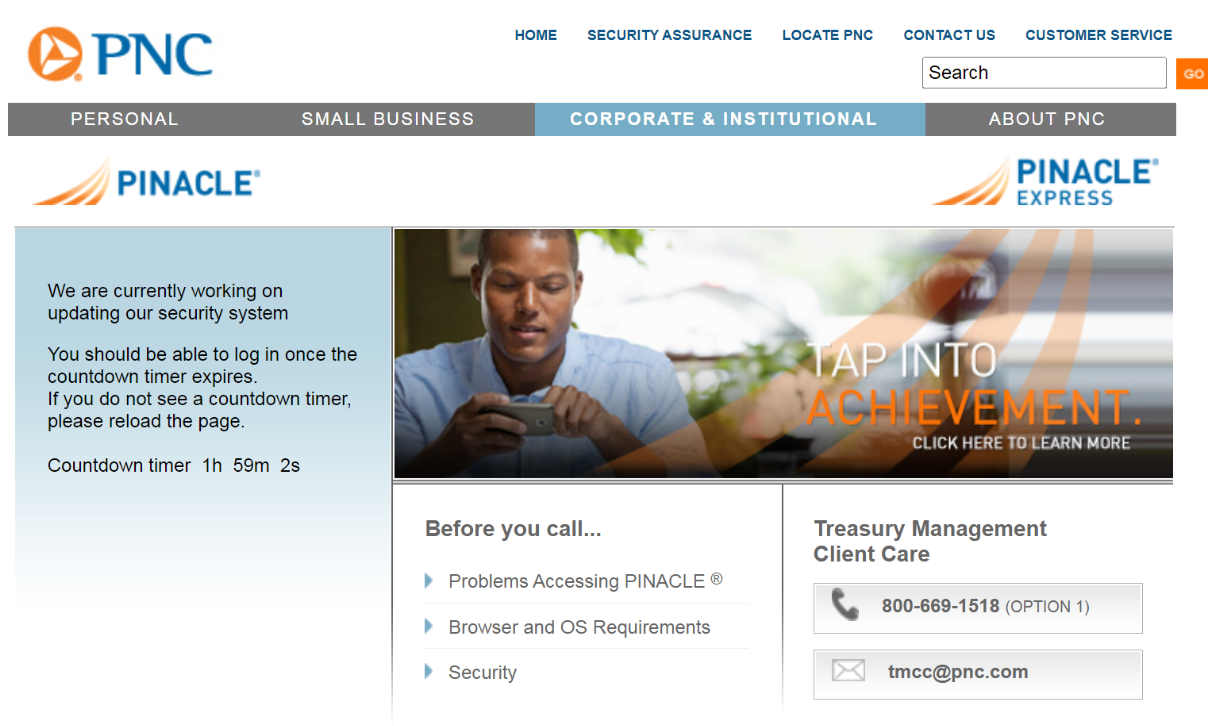
A fake PNC website overlay or “web inject” displaying a message intended to temporarily prevent the user from accessing their account.
The “SKIP” button in the screenshot above sends the user to the real bank login page, “in case the account is not interesting to us,” the manual explains. “Also, this redirect works if none of our operators are working at the time.”
The “TAKE” button in the Disneyland Team control panel allows users or affiliates to claim ownership over a specific infected machine or bot, which then excludes other users from interacting with that victim.
In the event that it somehow takes a long time to get the victim (bot) connected to the Disneyland Team control panel, or if it is necessary to delay a transaction, users can push a button that prompts the following message to appear on the victim’s screen:
“Your case ID number is 875472. An online banking support representative will get in touch shortly. Please provide your case ID number, and DO NOT close this page.”
The Disneyland user manual explains that the panel can be used to force the victim to log in again if they transmit invalid credentials. It also has other options for stalling victims whilst their accounts are drained. Another fake prompt the panel can produce shows the victim a message saying, “We are currently working on updating our security system. You should be able to log in once the countdown timer expires.”
The user manual says this option blocks the user from accessing their account for two hours. “It is possible to block for an hour with this button, in this case they get less frustrated, within the hours ddos will kill their network.”
Cybercrime groups will sometimes launch distributed denial-of-service (DDoS) attacks on the servers of the companies they’re trying to rob — which is usually intended to distract victims from their fleecing, although Holden said it’s unclear if the Disneyland Team employs this tactic as well.
For many years, KrebsOnSecurity tracked the day-to-day activities of a similar malware crew that used web injects and bots to steal tens of millions of dollars from small- to mid-sized businesses across the United States.
At the end of each story, I would close with a recommendation that anyone concerned about malware snarfing their banking information should strongly consider doing their online banking from a dedicated, security-hardened system which is only used for that purpose. Of course, the dedicated system approach works only if you always use that dedicated system for managing your account online.
Those stories also observed that since the vast majority of the malicious software used in cyberheists is designed to run only on Microsoft Windows computers, it made sense to pick a non-Windows computer for that dedicated banking system, such as a Mac or even a version of Linux. I still stand by this advice.
In case anyone is interested, here (PDF) is a list of all phishing domains currently and previously used by the Disneyland Team.


bs-1200













Let’s face it: Having “2022 election” in the headline above is probably the only reason anyone might read this story today. Still, while most of us here in the United States are anxiously awaiting the results of how well we’ve patched our Democracy, it seems fitting that Microsoft Corp. today released gobs of security patches for its ubiquitous Windows operating systems. November’s patch batch includes fixes for a whopping six zero-day security vulnerabilities that miscreants and malware are already exploiting in the wild.

Probably the scariest of the zero-day flaws is CVE-2022-41128, a “critical” weakness in the Windows scripting languages that could be used to foist malicious software on vulnerable users who do nothing more than browse to a hacked or malicious site that exploits the weakness. Microsoft credits Google with reporting the vulnerability, which earned a CVSS score of 8.8.
CVE-2022-41073 is a zero-day flaw in the Windows Print Spooler, a Windows component that Microsoft has patched mightily over the past year. Kevin Breen, director of cyber threat research at Immersive Labs, noted that the print spooler has been a popular target for vulnerabilities in the last 12 months, with this marking the 9th patch.
The third zero-day Microsoft patched this month is CVE-2022-41125, which is an “elevation of privilege” vulnerability in the Windows Cryptography API: Next Generation (CNG) Key Isolation Service, a service for isolating private keys. Satnam Narang, senior staff research engineer at Tenable, said exploitation of this vulnerability could grant an attacker SYSTEM privileges.
The fourth zero-day, CVE-2022-41091, was previously disclosed and widely reported on in October. It is a Security Feature Bypass of “Windows Mark of the Web” – a mechanism meant to flag files that have come from an untrusted source.
The other two zero-day bugs Microsoft patched this month were for vulnerabilities being exploited in Exchange Server. News that these two Exchange flaws were being exploited in the wild surfaced in late September 2022, and many were surprised when Microsoft let October’s Patch Tuesday sail by without issuing official patches for them (the company instead issued mitigation instructions that it was forced to revise multiple times). Today’s patch batch addresses both issues.
Greg Wiseman, product manager at Rapid7, said the Exchange flaw CVE-2022-41040 is a “critical” elevation of privilege vulnerability, and CVE-2022-41082 is considered Important, allowing Remote Code Execution (RCE) when PowerShell is accessible to the attacker.
“Both vulnerabilities have been exploited in the wild,” Wiseman said. “Four other CVEs affecting Exchange Server have also been addressed this month. Three are rated as Important, and CVE-2022-41080 is another privilege escalation vulnerability considered Critical. Customers are advised to update their Exchange Server systems immediately, regardless of whether any previously recommended mitigation steps have been applied. The mitigation rules are no longer recommended once systems have been patched.”
Adobe usually issues security updates for its products on Patch Tuesday, but it did not this month. For a closer look at the patches released by Microsoft today and indexed by severity and other metrics, check out the always-useful Patch Tuesday roundup from the SANS Internet Storm Center. And it’s not a bad idea to hold off updating for a few days until Microsoft works out any kinks in the updates: AskWoody.com usually has the lowdown on any patches that may be causing problems for Windows users.
As always, please consider backing up your system or at least your important documents and data before applying system updates. And if you run into any problems with these updates, please drop a note about it here in the comments.


ossl-code-1200



Cisconians delight in contributing to their communities in a variety of ways including at the local theatre, farm and library. Cisco’s paid Time2Give benefit encourages team members to volunteer at the places where their passions thrive.
How should you decide where to get involved? Customer Success Program Manager Kate Pydyn advises: “Find something that speaks to your passion while giving back. There are so many opportunities that involve being outdoors, crafting, teaching skills you’ve developed, telling stories or providing comfort.”
With ten paid days a year to give, these Cisconians demonstrate that building relationships with people, the arts and the earth can increase fulfillment, connection and community.
Urban farming is an issue very close to the heart of Petra Hammerl, a senior enterprise customer success manager who works on Duo Security. Hammerl frequently volunteers at Farm City Detroit, part of Detroit Blight Busters. Using Time2Give, Hammerl has shared the experience by “bringing a crew of awesome co-workers which has been amazing and a lot of fun,” she said.

“It felt great to take action! There are so many problems in the world, and I often feel powerless to make a difference. What I did was small, but with all of the volunteers together, the work that was done makes a real difference in the lives of my neighbors.” – Kate Pydyn
Pydyn and Emily Gennrich, a manager of operations for security customer success at Cisco Secure, joined in on the fun by contributing to multiple facets of gardening from weeding to harvesting food. “It felt great to take action! There are so many problems in the world, and I often feel powerless to make a difference. What I did was small, but with all of the volunteers together, the work that was done makes a real difference in the lives of my neighbors,” Pydyn said.
Senior Communications Manager, Brand Strategy & Design at Cisco Secure Chrysta Cherrie spent her Time2Give as a sighted assistant at the VISIONS vendor fair, hosted at the Ann Arbor District Library Downtown. “I was really happy to take some time to volunteer at the VISIONS vendor fair for people who are blind, visually impaired or physically disabled,” Cherrie said.

Learning how to be a sighted assistant was “a reminder that we can do more when we can rely on each other. Taking the time to better understand how someone makes their way through life gives you a chance to build empathy,” Cherrie said. She escorted attendees around the event where exhibitors offered products and services like electronic readers, leader dogs and transportation. There were also talks throughout the day and Cherrie helped attendees navigate between the presentation and vendor areas.
Meeting attendees of the VISIONS vendor fair and experiencing how meaningful the event is also moved Cherrie. The fair “brings out folks throughout southeast Michigan, so there’s a good chance that the person you’re assisting will run into some friends, and getting to see people connect like that can’t help but make you feel good,” Cherrie said.
Jenny Callans, a senior design researcher who works on Duo Security, serves as the chair of the Friends of the Detroit Film Theatre’s Auxiliary, a part of the Detroit Institute of Arts. “We support the mission of the Friends of the Detroit Film Theatre to make great niche films accessible to audiences,” she said. To do that, the organization is responsible for building a community of film fans and overseeing how donations are spent.

For Callans, the most meaningful part of using Time2Give to support the FDFT and the DIA is sharing her love of film with others. Time2Give supports her duties as FDFT chair, and gives her a sense of connection when she’s visiting the DFT to take in a movie. “Sitting in a theatre next to my young adult son, but surrounded by strangers watching a film that is unusual or unexpected but which moves me and challenges me to think is the best part hands-down,” Callans said.
From supporting youth to volunteering at community hubs, Time2Give “is a fantastic opportunity to have a long-lasting, meaningful relationship with your community by volunteering as a board or committee member! Having a long-term presence with an org is amazingly impactful, for you and for the organization,” Callans said.
Time2Give is one of Cherrie’s favorite things about working at Cisco. She says, “Take advantage of the opportunity! Time2Give is a great way to give back to your community and the people and causes that you care about.”
Stay tuned for more posts celebrating the community engagement Time2Give fosters and check out our open roles to join in on giving back.
We’d love to hear what you think. Ask a Question, Comment Below, and Stay Connected with Cisco Secure on social!
Cisco Secure Social Channels
Going beyond the hype, passwordless authentication is now a reality. Cisco Duo’s passwordless authentication is now generally available across all Duo Editions.
“Cisco Duo simplifies the passwordless journey for organizations that want to implement phishing-resistant authentication and adopt a zero trust security strategy.”
—Jack Poller, Senior Analyst, ESG
We received tremendous participation and feedback during our public preview, and we are now excited to bring this capability to our customers and prospects.
“Over the last few years, we have increased our password complexities and required 2FA wherever possible. With this approach, employees had more password lock outs, password fatigue, and forgetting their longer passwords due to password rotations. With Duo Passwordless, we are excited to introduce this feature to our employees to keep our password complexities in place and leverage different Biometric options whether that is using their mobile device, Windows Hello, or a provided FIDO security key.
The Duo Push for passwordless authentication feature is simple and easy and introduces a more pleasant experience overall. Using Duo’s device insight and application policies, we are able to leverage and verify the security of the mobile devices before the device is allowed to be used. To top it off, Duo is connected to our SIEM and our InfoSec team is able to review detailed logs and setup alerts to be able to keep everything secure.”
—Vice President of IT, Banking and Financial Services Customer
As with any new technology, getting to a completely passwordless state will be a journey for many organizations. We see customers typically starting their passwordless journey with web-based applications that support modern authentication. To that effect, Duo’s passwordless authentication is enabled through Duo Single Sign-On (SSO) for federated applications. Customers can choose to integrate their existing SAML Identity provider such as Microsoft (ADFS, Azure), Okta or Ping Identity; or choose to use Duo SSO (Available across all Duo editions).
“Password management is a challenging proposition for many enterprises, especially in light of BYOD and ever increasing sophistication of phishing schemes. Cisco aims to simplify the process with its Duo passwordless authentication that offers out-of-box integrations with popular single sign-on solutions.”
—Will Townsend, Vice President & Principal Analyst, Networking & Security, Moor Insights & Strategy
Duo offers a flexible choice of passwordless authentication options to meet the needs of businesses and their use cases. This includes:
No matter which authentication option you choose, it is secure and inherently multi-factor authentication. We are eliminating the need for the weak knowledge factor (something you know – passwords) which are shared during authentication and can be easily compromised. Instead, we are relying on stronger factors, which are the inherence factor (something you are – biometrics) and possession factor (something you have – a registered device). A user completes this authentication in a single gesture without having to remember a complex string of characters. This significantly improves the user experience and mitigates the risk of stolen credentials and man-in-the-middle (MiTM) attacks.
FIDO2 authentication is regarded as phishing-resistant authentication because it:
Using Duo with FIDO2 authenticators enables organizations to enforce phishing-resistant MFA in their environment. It also complies with the Office of Management and Budget (OMB) guidance issued earlier this year in a memo titled “Moving the U.S. Government Towards Zero Trust Cybersecurity Principles”. The memo specifically requires agencies to use phishing-resistant authentication method.
We understand that getting the IT infrastructure ready to support FIDO2 can be expensive and is typically a long-term project for organizations. In addition, deploying and managing 3rd party security keys creates IT overhead that some organizations are not able to undertake immediately.
Alternatively, using Duo Push for passwordless authentication is an easy, cost effective to get started on a passwordless journey for many organizations, without compromising on security.
We have incorporated security into the login workflow to bind the browser session and the device being used. So, organizations get the same benefits of eliminating use of stolen credentials and mitigation of phishing attacks. To learn more about passwordless authentication with Duo Push, check out our post: Available Now! Passwordless Authentication Is Just a Tap Away.
In addition to going passwordless, many organizations are looking to implement zero trust access in their IT environment. This environment typically is a mix of modern and legacy applications, meaning passwordless cannot be universally adopted. At least not until all applications can support modern authentication.
Additionally, organizations need to support a broad range of use cases to allow access from both managed and unmanaged (personal or 3rd party contractor) devices. And IT security teams need visibility into these devices and the ability to enforce compliance to meet the organization’s security policies such as ensuring that the operating system (OS) and web browser versions are up to date. The importance of verifying device posture at the time of authentication is emphasized in the guidance provided by OMB’s zero trust memorandum – “authorization systems should work to incorporate at least one device-level signal alongside identity information about the authenticated user.”
Duo can help organizations adopt a zero trust security model by enforcing strong user authentication across the board either through passwordless authentication where applicable or thought password + MFA where necessary, while providing a consistent user experience. Further, with capabilities such as device trust and granular adaptive policies, and with our vision for Continuous Trusted Access, organizations get a trusted security partner they can rely on for implementing zero trust access in their environment.
To learn more, check out the eBook – Passwordless: The Future of Authentication, which outlines a 5-step path to get started. And watch the passwordless product demo in this on-demand webinar .
Many of our customers have already begun their passwordless journey. If you are looking to get started as well, sign-up for a free trial and reach out to our amazing representatives.
We’d love to hear what you think. Ask a Question, Comment Below, and Stay Connected with Cisco Secure on social!
Cisco Secure Social Channels






It’s Partner Summit week and, for me, it’s an important reminder that no one company, not even Cisco, can do it alone. Our partners provide diverse perspectives, expertise, and solutions offerings. Each partner plays a key part in delivering the outcomes and experiences our customers need, want, and expect. So, when we say, “Let’s Own It”, it’s a rally cry for Cisco and our partners alike to do our parts to seize the massive opportunity that we have in front of us and turn it into mutual success.
Together, I know we can achieve amazing things. Foremost on my mind right now is both the opportunity and necessity to empower customers with security resilience. Resilience means customers can protect the integrity of every aspect of their business so that they can withstand unpredictable threats or changes and emerge stronger. It’s about providing controlled, trusted access to applications and services, at any time, from any place.
Resilience can also help customers deal with issues the moment they arise. If changes are needed, they will have the visibility to determine priorities, thanks to actionable intelligence and insight in the face of some major security realities that they are dealing with every day.
One, businesses are more interconnected, meaning that a breach on anyone in the value chain has dramatic ripple effects on the others.
Two, security attacks are becoming more personalized. Individuals remain one of the easiest targets for cybercriminals and their attacks are becoming more sophisticated and customized for the individual.
Three, hybrid work is here to stay. People around the world will continue to work from anywhere, on managed and unmanaged devices, over secured and unsecured networks, to applications spread across multiple clouds and data centers.
Our vision for enabling a more resilient organization is the Cisco Security Cloud. It’s an open, integrated security platform that will protect the integrity of entire IT ecosystems by safeguarding users, devices and applications across public clouds and private data centers, without public cloud lock-in. Delivering on the Security Cloud is part of our long-term product strategy; but the innovations we are announcing at Partner Summit this week are foundational elements that execute on this vision.
Specifically, we are announcing new solutions and technologies across our portfolio in Secure Connectivity, Network Security, and Zero Trust. I encourage all partners to drill down on each announcement in the accompanying blogs and news announcements. But here are the highlights of the announcements.
Helping increase resistance to phishing attacks and improve user experience through frictionless access using Duo Passwordless, which is now generally available with support for Duo Mobile as a passwordless authenticator.
Expanding the Cisco Secure Firewall 3100 series, the first firewall purpose-built for hybrid work, with the Secure Firewall 3105, ideal for branch office and similar use cases focused on performance at a competitive price point.
Strengthening Umbrella’s data loss prevention (DLP) capabilities by adding API-based enforcement and unified reporting to protect sensitive data, e.g., intellectual property and financial and healthcare information. This complements Umbrella’s current inline-DLP functionality and collectively forms multi-mode DLP.
New Secure Workload capabilities delivering policy-as-code workload security for cloud-native and public-cloud application development. Common use cases for policy-as-code include access control to infrastructure and simplifying enterprise compliance and controls.
Our strategy and our innovation roadmap are all designed to set you up, our partners, for long-term success. In addition, we are committed to several partner enablement programs to help you deliver more value to customers and to help you become more profitable. Examples include:
Partner Summit is for you. So, my call-to-action is for you to maximize the value you get out of this week by attending as many of the informative, high-impact security sessions many teams worked hard to create. I am really looking forward to meeting as many of you as possible – on the expo floor, at the sessions, or in our 1-on-1 meetings.
Security has never been more critical and the need for resiliency is a requirement for virtually every business. The time for us to own it and innovate to win this future together has never been better.
We’d love to hear what you think. Ask a Question, Comment Below, and Stay Connected with Cisco Secure on social!
Cisco Secure Social Channels










On October 10, 2022, there were 576,562 LinkedIn accounts that listed their current employer as Apple Inc. The next day, half of those profiles no longer existed. A similarly dramatic drop in the number of LinkedIn profiles claiming employment at Amazon comes as LinkedIn is struggling to combat a significant uptick in the creation of fake employee accounts that pair AI-generated profile photos with text lifted from legitimate users.
Jay Pinho is a developer who is working on a product that tracks company data, including hiring. Pinho has been using LinkedIn to monitor daily employee headcounts at several dozen large organizations, and last week he noticed that two of them had far fewer people claiming to work for them than they did just 24 hours previously.
Pinho’s screenshot below shows the daily count of employees as displayed on Amazon’s LinkedIn homepage. Pinho said his scraper shows that the number of LinkedIn profiles claiming current roles at Amazon fell from roughly 1.25 million to 838,601 in just one day, a 33 percent drop:
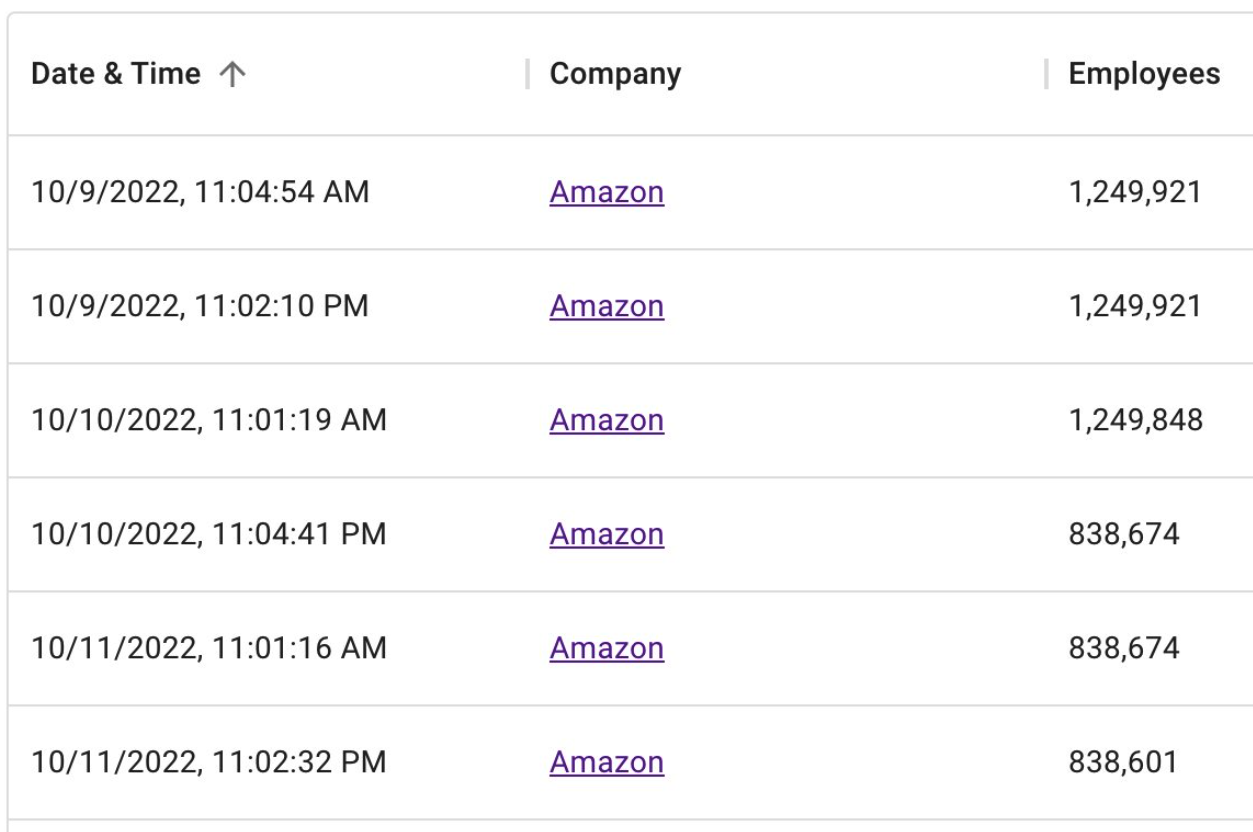
The number of LinkedIn profiles claiming current positions at Amazon fell 33 percent overnight. Image: twitter.com/jaypinho
As stated above, the number of LinkedIn profiles that claimed to work at Apple fell by approximately 50 percent on Oct. 10, according to Pinho’s analysis:
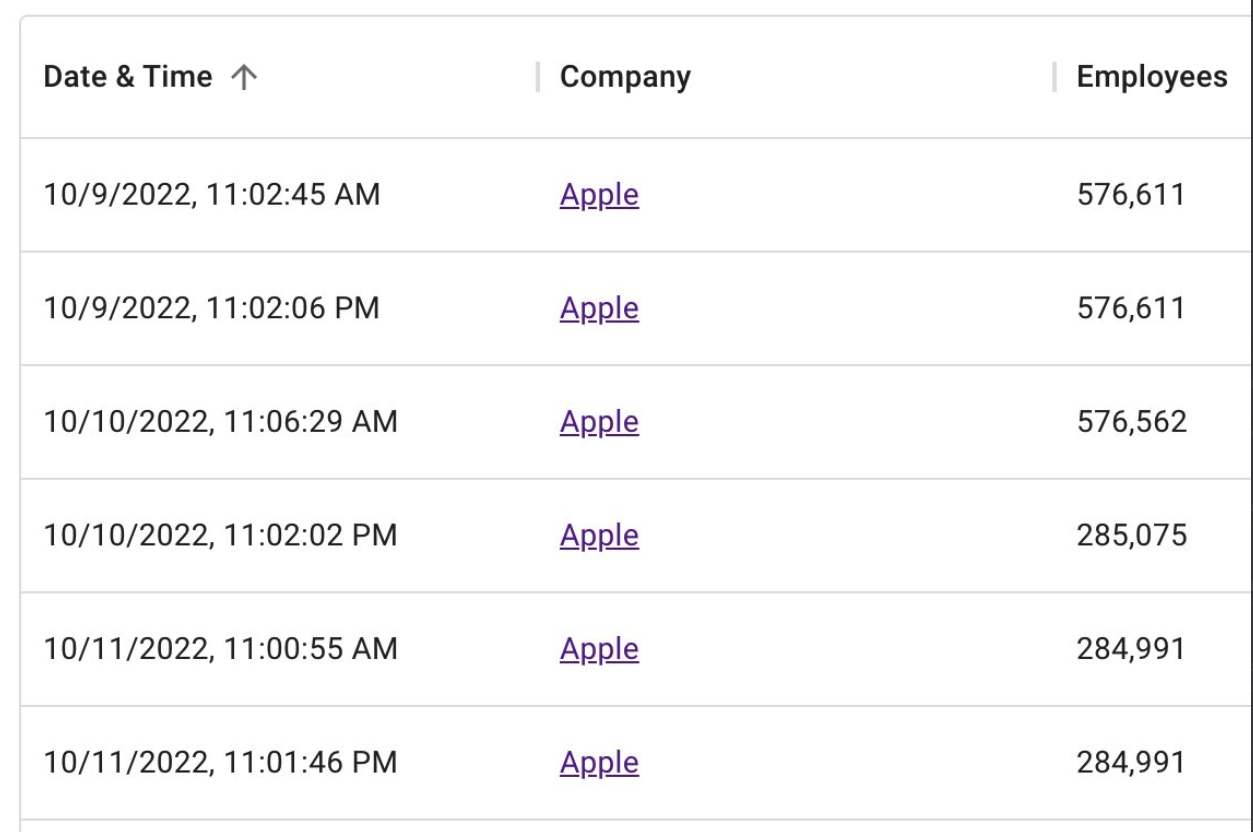
Image: twitter.com/jaypinho
Neither Amazon or Apple responded to requests for comment. LinkedIn declined to answer questions about the account purges, saying only that the company is constantly working to keep the platform free of fake accounts. In June, LinkedIn acknowledged it was seeing a rise in fraudulent activity happening on the platform.
KrebsOnSecurity hired Menlo Park, Calif.-based SignalHire to check Pinho’s numbers. SignalHire keeps track of active and former profiles on LinkedIn, and during the Oct 9-11 timeframe SignalHire said it saw somewhat smaller but still unprecedented drops in active profiles tied to Amazon and Apple.
“The drop in the percentage of 7-10 percent [of all profiles], as it happened [during] this time, is not something that happened before,” SignalHire’s Anastacia Brown told KrebsOnSecurity.
Brown said the normal daily variation in profile numbers for these companies is plus or minus one percent.
“That’s definitely the first huge drop that happened throughout the time we’ve collected the profiles,” she said.
In late September 2022, KrebsOnSecurity warned about the proliferation of fake LinkedIn profiles for Chief Information Security Officer (CISO) roles at some of the world’s largest corporations. A follow-up story on Oct. 5 showed how the phony profile problem has affected virtually all executive roles at corporations, and how these fake profiles are creating an identity crisis for the businesses networking site and the companies that rely on it to hire and screen prospective employees.
A day after that second story ran, KrebsOnSecurity heard from a recruiter who noticed the number of LinkedIn profiles that claimed virtually any role in network security had dropped seven percent overnight. LinkedIn declined to comment about that earlier account purge, saying only that, “We’re constantly working at taking down fake accounts.”

A “swarm” of LinkedIn AI-generated bot accounts flagged by a LinkedIn group administrator recently.
It’s unclear whether LinkedIn is responsible for this latest account purge, or if individually affected companies are starting to take action on their own. The timing, however, argues for the former, as the account purges for Apple and Amazon employees tracked by Pinho appeared to happen within the same 24 hour period.
It’s also unclear who or what is behind the recent proliferation of fake executive profiles on LinkedIn. Cybersecurity firm Mandiant (recently acquired by Google) told Bloomberg that hackers working for the North Korean government have been copying resumes and profiles from leading job listing platforms LinkedIn and Indeed, as part of an elaborate scheme to land jobs at cryptocurrency firms.
On this point, Pinho said he noticed an account purge in early September that targeted fake profiles tied to jobs at cryptocurrency exchange Binance. Up until Sept. 3, there were 7,846 profiles claiming current executive roles at Binance. The next day, that number stood at 6,102, a 23 percent drop (by some accounts that 6,102 head count is still wildly inflated).

Fake profiles also may be tied to so-called “pig butchering” scams, wherein people are lured by flirtatious strangers online into investing in cryptocurrency trading platforms that eventually seize any funds when victims try to cash out.
In addition, identity thieves have been known to masquerade on LinkedIn as job recruiters, collecting personal and financial information from people who fall for employment scams.
Nicholas Weaver, a researcher for the International Computer Science Institute at University of California, Berkeley, suggested another explanation for the recent glut of phony LinkedIn profiles: Someone may be setting up a mass network of accounts in order to more fully scrape profile information from the entire platform.
“Even with just a standard LinkedIn account, there’s a pretty good amount of profile information just in the default two-hop networks,” Weaver said. “We don’t know the purpose of these bots, but we know creating bots isn’t free and creating hundreds of thousands of bots would require a lot of resources.”
In response to last week’s story about the explosion of phony accounts on LinkedIn, the company said it was exploring new ways to protect members, such as expanding email domain verification. Under such a scheme, LinkedIn users would be able to publicly attest that their profile is accurate by verifying that they can respond to email at the domain associated with their current employer.
LinkedIn claims that its security systems detect and block approximately 96 percent of fake accounts. And despite the recent purges, LinkedIn may be telling the truth, Weaver said.
“There’s no way you can test for that,” he said. “Because technically, it may be that there were actually 100 million bots trying to sign up at LinkedIn as employees at Amazon.”
Weaver said the apparent mass account purge at LinkedIn underscores the size of the bot problem, and could present a “real and material change” for LinkedIn.
“It may mean the statistics they’ve been reporting about usage and active accounts are off by quite a bit,” Weaver said.





act-1200


AMLBot, a service that helps businesses avoid transacting with cryptocurrency wallets that have been sanctioned for cybercrime activity, said an investigation published by KrebsOnSecurity last year helped it shut down three dark web services that secretly resold its technology to help cybercrooks avoid detection by anti-money laundering systems.
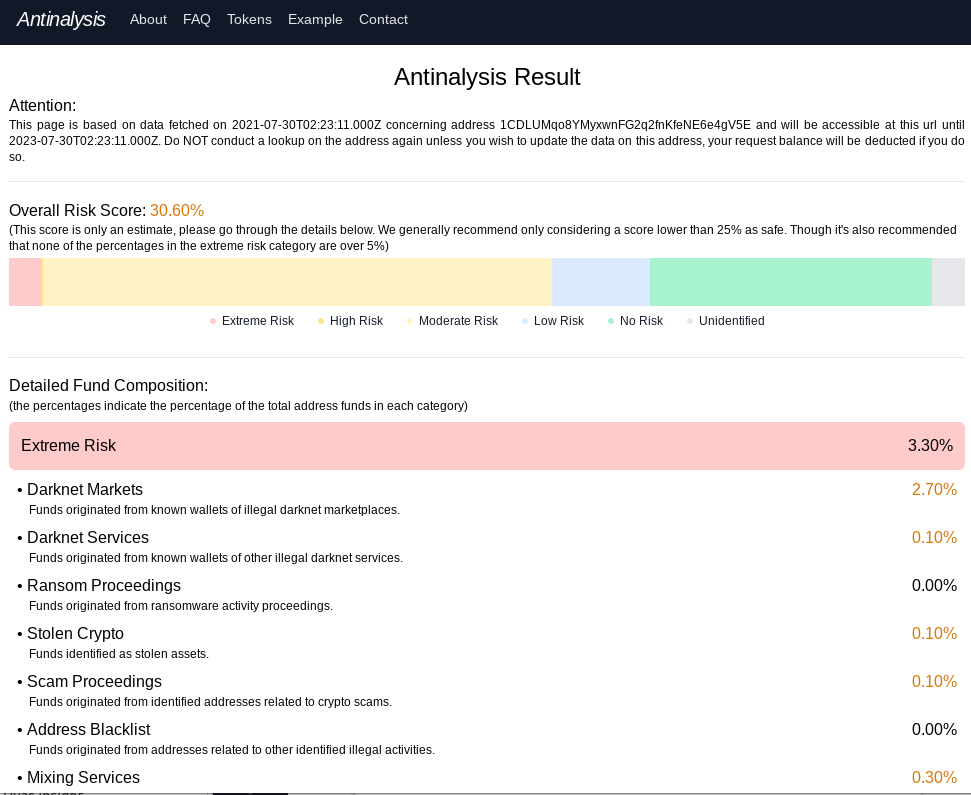
Antinalysis, as it existed in 2021.
In August 2021, KrebsOnSecurity published “New Anti Anti-Money Laundering Services for Crooks,” which examined Antinalysis, a service marketed on cybercrime forums that purported to offer a glimpse of how one’s payment activity might be flagged by law enforcement agencies and private companies that track and trace cryptocurrency transactions.
“Worried about dirty funds in your BTC address? Come check out Antinalysis, the new address risk analyzer,” read the service’s opening announcement. “This service is dedicated to individuals that have the need to possess complete privacy on the blockchain, offering a perspective from the opponent’s point of view in order for the user to comprehend the possibility of his/her funds getting flagged down under autocratic illegal charges.”
Antinalysis allows free lookups, but anyone wishing to conduct bulk look-ups has to pay at least USD $3, with a minimum $30 purchase. Other plans go for as high as $6,000 for 5,000 requests. Nick Bax, a security researcher who specializes in tracing cryptocurrency transactions, told KrebsOnSecurity at the time that Antinalysis was likely a clone of AMLBot because the two services generated near-identical results.
AMLBot shut down Antinalysis’s access just hours after last year’s story went live. However, Antinalysis[.]org remains online and accepting requests, as does the service’s Tor-based domain, and it is unclear how those services are sourcing their information.
AMLBot spokesperson Polina Smoliar said the company undertook a thorough review after that discovery, and in the process found two other services similar to Antinalysis that were reselling their application programming interface (API) access to cybercrooks.
Smoliar said that following the revelations about Antinalysis, AMLBot audited its entire client base, and implemented the ability to provide APIs only after a contract is signed and the client has been fully audited. AMLBot said it also instituted 24/7 monitoring of all client transactions.
“As a result of these actions, two more services with the name AML (the same as AMLBot has) were found to be involved in fraudulent schemes,” Smoliar said. “Information about the fraudsters was also sent to key market participants, and their transaction data was added to the tracking database to better combat money laundering.”
The Antinalysis homepage and chatter on the cybercrime forums indicates the service was created by a group of coders known as the Incognito Team. Tom Robinson, co-founder of the blockchain intelligence firm Elliptic, said the creator of Antinalysis is also one of the developers of Incognito Market, a darknet marketplace specializing in the sale of narcotics.
“Incognito was launched in late 2020, and accepts payments in both Bitcoin and Monero, a cryptoasset offering heightened anonymity,” Robinson said. “The launch of Antinalysis likely reflects the difficulties faced by the market and its vendors in cashing out their Bitcoin proceeds.”
Microsoft today released updates to fix at least 85 security holes in its Windows operating systems and related software, including a new zero-day vulnerability in all supported versions of Windows that is being actively exploited. However, noticeably absent from this month’s Patch Tuesday are any updates to address a pair of zero-day flaws being exploited this past month in Microsoft Exchange Server.

The new zero-day flaw– CVE-2022-41033 — is an “elevation of privilege” bug in the Windows COM+ event service, which provides system notifications when users logon or logoff. Microsoft says the flaw is being actively exploited, and that it was reported by an anonymous individual.
“Despite its relatively low score in comparison to other vulnerabilities patched today, this one should be at the top of everyone’s list to quickly patch,” said Kevin Breen, director of cyber threat research at Immersive Labs. “This specific vulnerability is a local privilege escalation, which means that an attacker would already need to have code execution on a host to use this exploit. Privilege escalation vulnerabilities are a common occurrence in almost every security compromise. Attackers will seek to gain SYSTEM or domain-level access in order to disable security tools, grab credentials with tools like Mimkatz and move laterally across the network.
Indeed, Satnam Narang, senior staff research engineer at Tenable, notes that almost half of the security flaws Microsoft patched this week are elevation of privilege bugs.
Some privilege escalation bugs can be particularly scary. One example is CVE-2022-37968, which affects organizations running Kubernetes clusters on Azure and earned a CVSS score of 10.0 — the most severe score possible.
Microsoft says that to exploit this vulnerability an attacker would need to know the randomly generated DNS endpoint for an Azure Arc-enabled Kubernetes cluster. But that may not be such a tall order, says Breen, who notes that a number of free and commercial DNS discovery services now make it easy to find this information on potential targets.
Late last month, Microsoft acknowledged that attackers were exploiting two previously unknown vulnerabilities in Exchange Server. Paired together, the two flaws are known as “ProxyNotShell” and they can be chained to allow remote code execution on Exchange Server systems.
Microsoft said it was expediting work on official patches for the Exchange bugs, and it urged affected customers to enable certain settings to mitigate the threat from the attacks. However, those mitigation steps were soon shown to be ineffective, and Microsoft has been adjusting them on a daily basis nearly each day since then.
The lack of Exchange patches leaves a lot of Microsoft customers exposed. Security firm Rapid7 said that as of early September 2022 the company observed more than 190,000 potentially vulnerable instances of Exchange Server exposed to the Internet.
“While Microsoft confirmed the zero-days and issued guidance faster than they have in the past, there are still no patches nearly two weeks out from initial disclosure,” said Caitlin Condon, senior manager of vulnerability research at Rapid7. “Despite high hopes that today’s Patch Tuesday release would contain fixes for the vulnerabilities, Exchange Server is conspicuously missing from the initial list of October 2022 security updates. Microsoft’s recommended rule for blocking known attack patterns has been bypassed multiple times, emphasizing the necessity of a true fix.”
Adobe also released security updates to fix 29 vulnerabilities across a variety of products, including Acrobat and Reader, ColdFusion, Commerce and Magento. Adobe said it is not aware of active attacks against any of these flaws.
For a closer look at the patches released by Microsoft today and indexed by severity and other metrics, check out the always-useful Patch Tuesday roundup from the SANS Internet Storm Center. And it’s not a bad idea to hold off updating for a few days until Microsoft works out any kinks in the updates: AskWoody.com usually has the lowdown on any patches that may be causing problems for Windows users.
As always, please consider backing up your system or at least your important documents and data before applying system updates. And if you run into any problems with these updates, please drop a note about it here in the comments.



Giving back is part of the ethos at Cisco. Part of how that happens is through employees volunteering as part of Cisco’s Time2Give benefit in which employees can use paid time to contribute to their communities and support the causes they’re passionate about. During the pandemic, Cisco increased this benefit from five paid volunteering days to 10 and encourages virtual volunteering, too.

Elizabeth Chang, a software engineer on the Duo Security platform services team, considers Time2Give a great opportunity to “invest in people around you. It is amazing that Cisco supports what we are passionate about and that we can use this time to grow ourselves in other areas of life,” she said.
Cisconians care deeply about many causes, and this post celebrates how teammates spend their time supporting children, youth and teens in and out of school and those preparing for college. Stay tuned for future posts highlighting how other employees give their time. You may even be inspired to find out how you can develop your skills while contributing to organizations that matter to you!
Pierpaolo Panarotto, an account executive on Duo’s EMEAR continental team, volunteers at Sport senza frontiere onlus, a summer sports camp in Italy for refugee children. This summer Panarotto tutored and taught badminton. The program also welcomed children from Ukraine this year.

For Panarotto, the best part, hands down, was seeing the children’s smiles. He advised, “Give back to your community. Sometimes we forget how lucky we are.”
Chang also volunteered at a summer camp, supporting middle and high school students in Boston. The program she supported, Area Youth Ministry Leadership Camp and Summer Boost, fosters leadership skills and college readiness while promoting mentorship.
By helping lead a coding workshop, Chang was able to share what she does professionally. “I was glad that I got to help inspire youth to pursue computer science,” she said. The camp was such a hit that many participants “didn’t want to go home because they had such a fun time,” Chang shared.

“Take the time! You’ll never get the opportunity to go back and take it later. Your community and your heart will thank you!” – Sarah Moon-Musser
Now that school has started, Engineering Program Manager in Platform Engineering Sarah Moon-Musser helps teach the Belleville High School Marching Band’s color guard choreography for their halftime show. She loves spending time with the students. To those considering utilizing Time2Give Moon-Musser says, “Take the time! You’ll never get the opportunity to go back and take it later. Your community and your heart will thank you!”
College readiness is also a passion for Justin Fan and Seema Kathuria who both volunteer with Code2College. They’re able to volunteer virtually by reviewing resumes and college entrance essays and providing constructive feedback through shared documents.
Senior Product Marketing Manager, Kathuria appreciates “learning about the experiences of high school students and how they approach writing about their accomplishments,” she said.

For Fan, a senior customer success manager in security customer success, “the best part is supporting younger generations as they move into college and career. They’re so much more focused and mature than I was at their age,” he said. Fan also participates in virtual career workshops with high school and college students with Students Rising Above.

For others wanting to use Time2Give, Fan suggests finding opportunities you’re passionate about and utilizing light meeting days to volunteer. Kathuria says, “Take advantage of the 10 Time2Give days per year that Cisco gives us. It is very generous, and it feels so good to give back to the community in whatever way makes you happy and fulfilled.”
If you’re looking to feel fulfilled by your work and the impact you can make, please check out our open roles.
We’d love to hear what you think. Ask a Question, Comment Below, and Stay Connected with Cisco Secure on social!
Cisco Secure Social Channels
A recent proliferation of phony executive profiles on LinkedIn is creating something of an identity crisis for the business networking site, and for companies that rely on it to hire and screen prospective employees. The fabricated LinkedIn identities — which pair AI-generated profile photos with text lifted from legitimate accounts — are creating major headaches for corporate HR departments and for those managing invite-only LinkedIn groups.

Some of the fake profiles flagged by the co-administrator of a popular sustainability group on LinkedIn.
Last week, KrebsOnSecurity examined a flood of inauthentic LinkedIn profiles all claiming Chief Information Security Officer (CISO) roles at various Fortune 500 companies, including Biogen, Chevron, ExxonMobil, and Hewlett Packard.
Since then, the response from LinkedIn users and readers has made clear that these phony profiles are showing up en masse for virtually all executive roles — but particularly for jobs and industries that are adjacent to recent global events and news trends.
Hamish Taylor runs the Sustainability Professionals group on LinkedIn, which has more than 300,000 members. Together with the group’s co-owner, Taylor said they’ve blocked more than 12,700 suspected fake profiles so far this year, including dozens of recent accounts that Taylor describes as “cynical attempts to exploit Humanitarian Relief and Crisis Relief experts.”
“We receive over 500 fake profile requests to join on a weekly basis,” Taylor said. “It’s hit like hell since about January of this year. Prior to that we did not get the swarms of fakes that we now experience.”
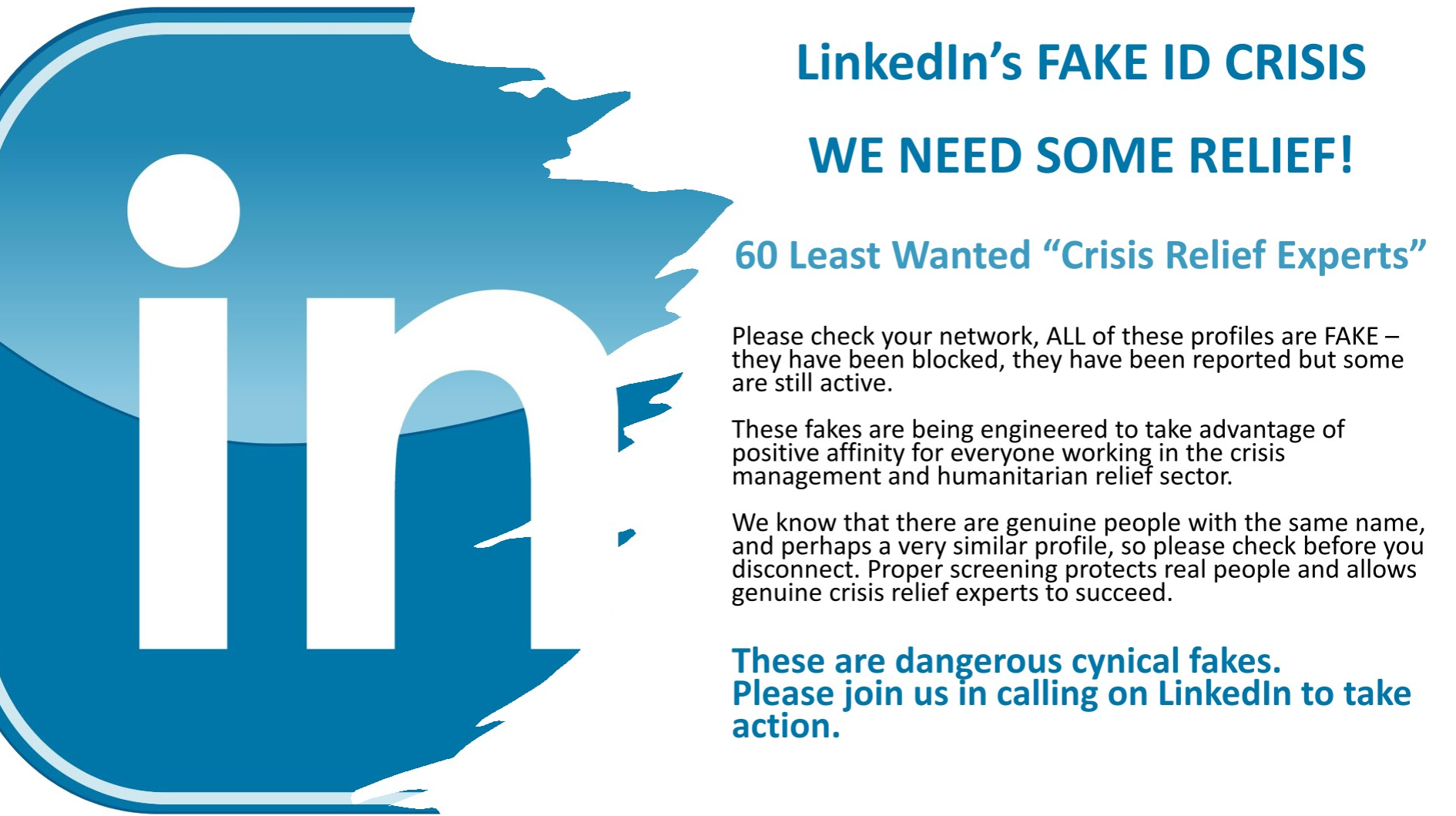
The opening slide for a plea by Taylor’s group to LinkedIn.
Taylor recently posted an entry on LinkedIn titled, “The Fake ID Crisis on LinkedIn,” which lampooned the “60 Least Wanted ‘Crisis Relief Experts’ — fake profiles that claimed to be experts in disaster recovery efforts in the wake of recent hurricanes. The images above and below show just one such swarm of profiles the group flagged as inauthentic. Virtually all of these profiles were removed from LinkedIn after KrebsOnSecurity tweeted about them last week.

Another “swarm” of LinkedIn bot accounts flagged by Taylor’s group.
Mark Miller is the owner of the DevOps group on LinkedIn, and says he deals with fake profiles on a daily basis — often hundreds per day. What Taylor called “swarms” of fake accounts Miller described instead as “waves” of incoming requests from phony accounts.
“When a bot tries to infiltrate the group, it does so in waves,” Miller said. “We’ll see 20-30 requests come in with the same type of information in the profiles.”
After screenshotting the waves of suspected fake profile requests, Miller started sending the images to LinkedIn’s abuse teams, which told him they would review his request but that he may never be notified of any action taken.

Some of the bot profiles identified by Mark Miller that were seeking access to his DevOps LinkedIn group. Miller said these profiles are all listed in the order they appeared.
Miller said that after months of complaining and sharing fake profile information with LinkedIn, the social media network appeared to do something which caused the volume of group membership requests from phony accounts to drop precipitously.
“I wrote our LinkedIn rep and said we were considering closing the group down the bots were so bad,” Miller said. “I said, ‘You guys should be doing something on the backend to block this.”
Jason Lathrop is vice president of technology and operations at ISOutsource, a Seattle-based consulting firm with roughly 100 employees. Like Miller, Lathrop’s experience in fighting bot profiles on LinkedIn suggests the social networking giant will eventually respond to complaints about inauthentic accounts. That is, if affected users complain loudly enough (posting about it publicly on LinkedIn seems to help).
Lathrop said that about two months ago his employer noticed waves of new followers, and identified more than 3,000 followers that all shared various elements, such as profile photos or text descriptions.
“Then I noticed that they all claim to work for us at some random title within the organization,” Lathrop said in an interview with KrebsOnSecurity. “When we complained to LinkedIn, they’d tell us these profiles didn’t violate their community guidelines. But like heck they don’t! These people don’t exist, and they’re claiming they work for us!”
Lathrop said that after his company’s third complaint, a LinkedIn representative responded by asking ISOutsource to send a spreadsheet listing every legitimate employee in the company, and their corresponding profile links.
Not long after that, the phony profiles that were not on the company’s list were deleted from LinkedIn. Lathrop said he’s still not sure how they’re going to handle getting new employees allowed into their company on LinkedIn going forward.
It remains unclear why LinkedIn has been flooded with so many fake profiles lately, or how the phony profile photos are sourced. Random testing of the profile photos shows they resemble but do not match other photos posted online. Several readers pointed out one likely source — the website thispersondoesnotexist.com, which makes using artificial intelligence to create unique headshots a point-and-click exercise.
Cybersecurity firm Mandiant (recently acquired by Google) told Bloomberg that hackers working for the North Korean government have been copying resumes and profiles from leading job listing platforms LinkedIn and Indeed, as part of an elaborate scheme to land jobs at cryptocurrency firms.
Fake profiles also may be tied to so-called “pig butchering” scams, wherein people are lured by flirtatious strangers online into investing in cryptocurrency trading platforms that eventually seize any funds when victims try to cash out.
In addition, identity thieves have been known to masquerade on LinkedIn as job recruiters, collecting personal and financial information from people who fall for employment scams.
But the Sustainability Group administrator Taylor said the bots he’s tracked strangely don’t respond to messages, nor do they appear to try to post content.
“Clearly they are not monitored,” Taylor assessed. “Or they’re just created and then left to fester.”
This experience was shared by the DevOp group admin Miller, who said he’s also tried baiting the phony profiles with messages referencing their fakeness. Miller says he’s worried someone is creating a massive social network of bots for some future attack in which the automated accounts may be used to amplify false information online, or at least muddle the truth.
“It’s almost like someone is setting up a huge bot network so that when there’s a big message that needs to go out they can just mass post with all these fake profiles,” Miller said.
In last week’s story on this topic, I suggested LinkedIn could take one simple step that would make it far easier for people to make informed decisions about whether to trust a given profile: Add a “created on” date for every profile. Twitter does this, and it’s enormously helpful for filtering out a great deal of noise and unwanted communications.
Many of our readers on Twitter said LinkedIn needs to give employers more tools — perhaps some kind of application programming interface (API) — that would allow them to quickly remove profiles that falsely claim to be employed at their organizations.
Another reader suggested LinkedIn also could experiment with offering something akin to Twitter’s verified mark to users who chose to validate that they can respond to email at the domain associated with their stated current employer.
In response to questions from KrebsOnSecurity, LinkedIn said it was considering the domain verification idea.
“This is an ongoing challenge and we’re constantly improving our systems to stop fakes before they come online,” LinkedIn said in a written statement. “We do stop the vast majority of fraudulent activity we detect in our community – around 96% of fake accounts and around 99.1% of spam and scams. We’re also exploring new ways to protect our members such as expanding email domain verification. Our community is all about authentic people having meaningful conversations and to always increase the legitimacy and quality of our community.”
In a story published Wednesday, Bloomberg noted that LinkedIn has largely so far avoided the scandals about bots that have plagued networks like Facebook and Twitter. But that shine is starting to come off, as more users are forced to waste more of their time fighting off inauthentic accounts.
“What’s clear is that LinkedIn’s cachet as being the social network for serious professionals makes it the perfect platform for lulling members into a false sense of security,” Bloomberg’s Tim Cuplan wrote. “Exacerbating the security risk is the vast amount of data that LinkedIn collates and publishes, and which underpins its whole business model but which lacks any robust verification mechanisms.”